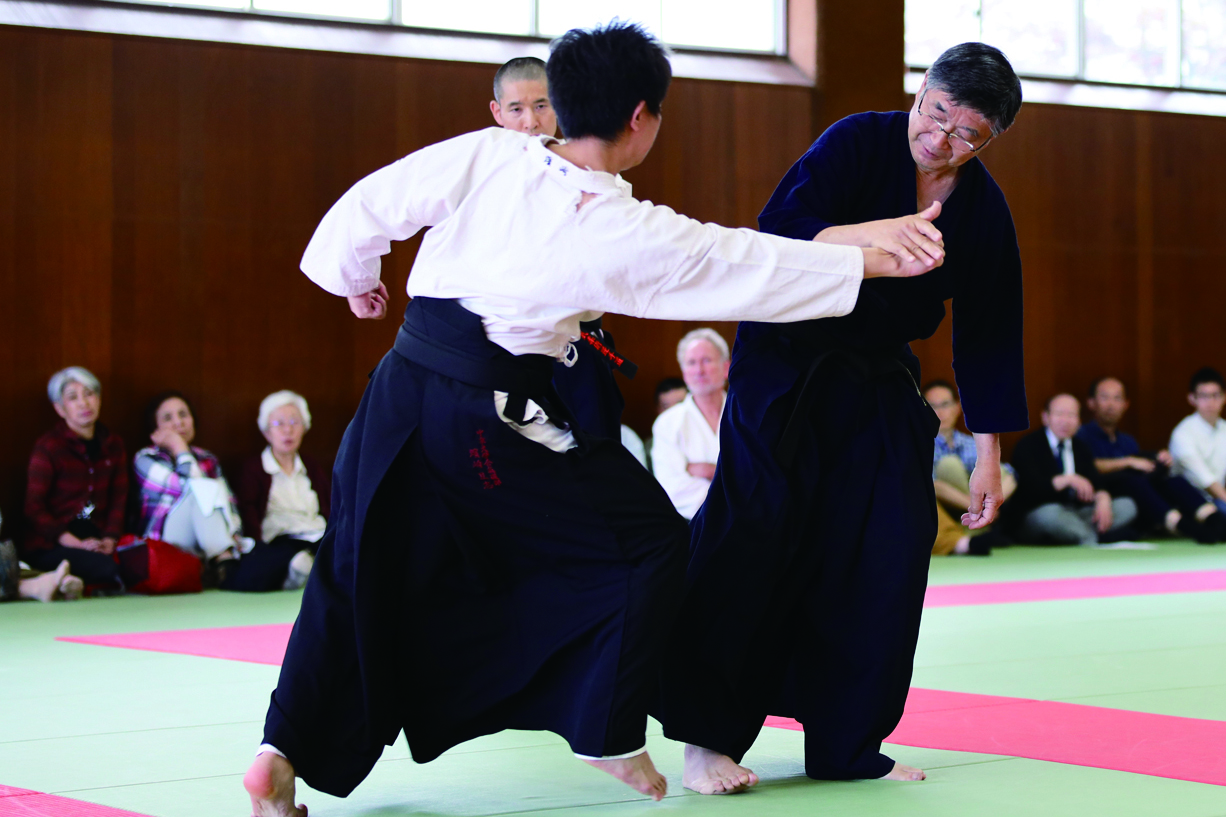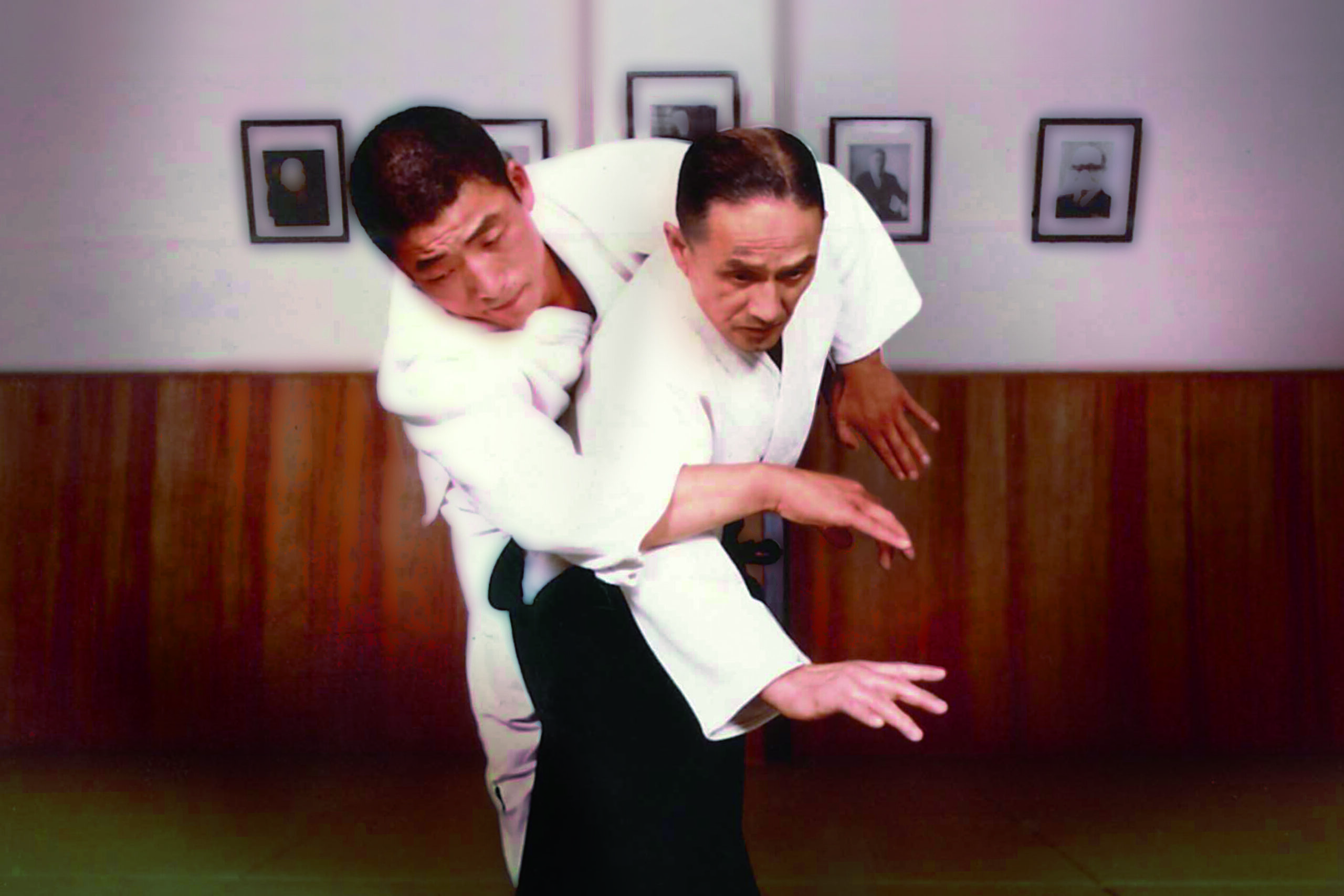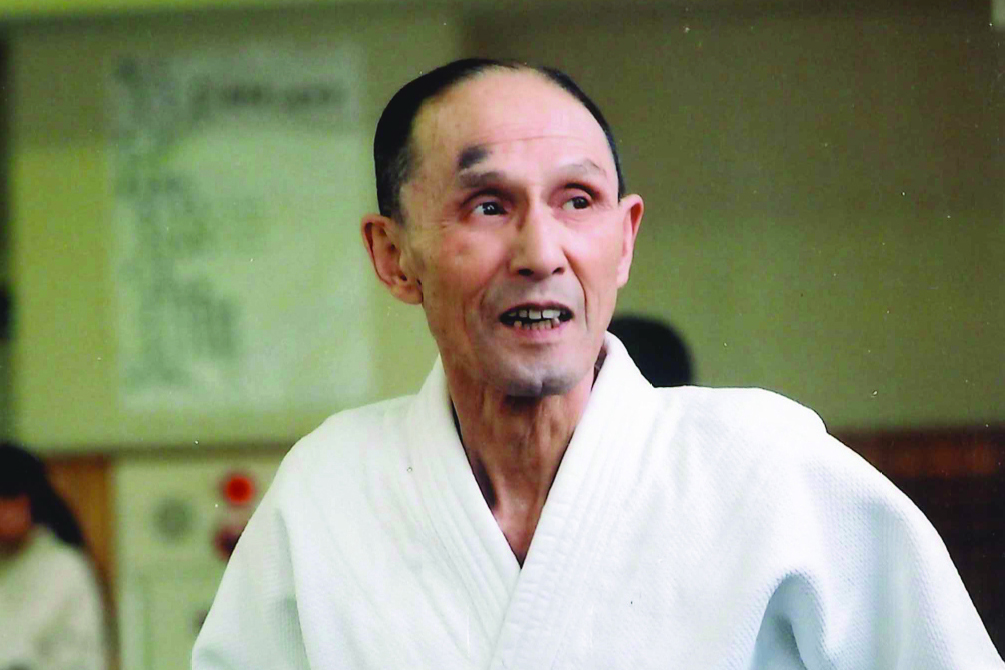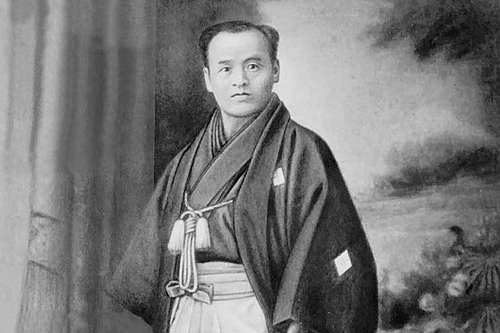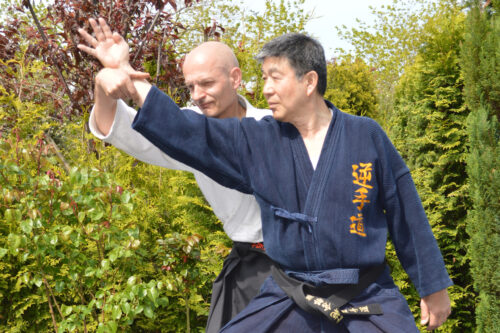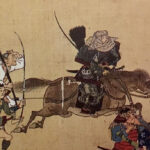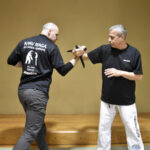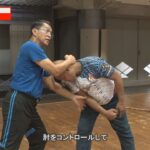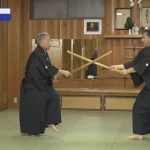» At the starting of AIKI Web Course
【AIKI JUJUTSU GYAKUTE-DO Series No.5】How you can learn Jujutsu properly
5.1 First you should know the difference between traditional Japanese Jujutsu and the other “Jujutsu”
Jujutsu , JuJitsu or JiuJitsu, what else
There sometimes occurs a discussion among non-Japanese Jujutsu practitioners about which is correct, Jujutsu or Jujitsu, or the other versions such as Ju-Jutsu, Ju-Jitsu, Jiu-Jitsu, etc. Such discussion could never occur among Japanese Jujutsu-ka (Jujutsu exponents) because for us, only Jujutsu is correct. Not many but there are several martial arts named as ~jitsu same as Jujitsu. All of those which have name of ~jitsu seem like Japanese martial arts, or they claim those have Japanese origin. From the point of view as a Japanese person, there is a simple way to recognize which is real Japanese origin among them. By its naming, if it has a naming such as XXX-jitsu, it is surely not of Japanese origin because the Japanese word “Jitsu” (実) means real, truth, seeds, etc. and “Jutsu” (術) means arts. For instance, “Jujutsu” is written 柔術, which means arts of soft techniques, and “Jujitsu” 充実 means enrichment, fullness, substantiality, etc.
Just as an example, there is a system named X-jitsu which is popular in Europe and recently it was introduced into Japan. When they established their branch organization in Japan they renamed this system by taking away “jitsu” and just used X without jitsu. I can easily imagine why they had to change the name, because if they keep its original name as X-jitsu, it sounds strange enough that almost all Japanese would start to doubt its merit. Accordingly, they had to decide whether to change jitsu to jutsu or just erase it completely and name it “X” to be accepted in Japan, although it is still strange enough as a name of Bujutsu for us Japanese.
How and where this wrong spelling JuJitsu has occured ?
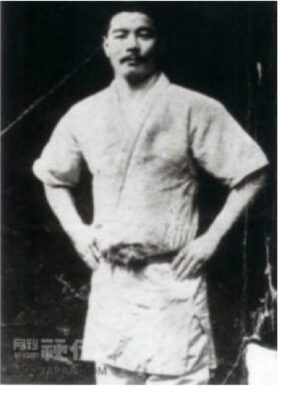 Jujutsu pionere in Europe, Master Mitsuyo MAEDA
Jujutsu pionere in Europe, Master Mitsuyo MAEDA
The first Japanese martial arts introduced into Europe (i.e., outside of Japan) was Jujutsu. It was in the beginning of the 20th century. At that time Judo (which is derived from Jujutsu) had been becoming a major Budo (martial arts of Japan) because of its rational and systematic teaching method and competition. Many Jujutsu people had been converting from Jujutsu to Judo but there were a few who did not want to join this new Judo which was recently created by Master Jigoro KANO, based on the traditional Jujutsu, so they went over to Europe (i.e., U.K., France, etc.) to search for a new place where they can introduce their Jujutsu to allow it to survive. They showed their miracle techniques to European people by which they defeated much bigger wrestlers than themselves, and those small Japanese Jujutsu-ka attracted a lot of fighting system enthusiasts in Europe. Mainly they taught their Jujutsu in London and Paris, so many people came to those two cities from all over Europe to learn their miracle techniques.
The most of those Japanese Jujutsu-ka came from outlying areas far from big cities in Japan, so they might pronounce Jujutsu as Jujitsu with their dialect, although they wrote Jujutsu in Japanese characters. And/or their students might have misheard their teacher’s pronunciation as Jujitsu. Regardless, those Japanese Jujutsu-ka taught their European students only verbally but not by text due to their poor English. In whichever case, the contacts between those Japanese teachers and European students at that time were not long nor deep enough and that mistake (i.e. spelling mistake) arose without correction by their Japanese teachers. No more than 10 years had past since those Japanese Jujutsu masters came to Europe and started introducing Jujutsu, some of them came back to Japan or went over to the U.S.A. to explore new activities. Following this, the second world war occurred and any contact between those Japanese Jujutsu teachers and their European students was lost. After the war, although they wished their teachers would come back to Europe to teach them Jujutsu again, those teachers never came back to Europe because most of skilled Jujutsu masters were killed on the battle field and Jujutsu itself had nearly disappeared in Japan due to few masters being left and even fewer students. Accordingly, the European students had to continue their training without teachers and during that time many important secrets and deep knowledge was lost. Also, it could be explained that not all the deep knowledge was transferred to them due to such a short period of instruction and contact. This is what we call traditional European Jujutsu, although they spell it as Jujitsu. Although that Jujitsu does not have a lot of important deep knowledge they still carry the basic system of real Japanese Jujutsu, so we recognise those Jujitsu as a part of real Jujutsu. When they re-learn important deep knowledge from Japanese masters they finally notice their wrong naming and shall start using correct naming as Jujutsu. I am very happy to find that several Jujitsu organizations in Europe changed(corrected) their name to Jujutsu and many did in Indonesia, either.
Further degeneration of Europeam Jujitsu (Jujutsu)
In early 1970s Japanese Budo has started becoming popular outside of Japan because Judo was becoming well known world wide. Then many Judo masters went abroad to introduce Judo. Then after, Karate followed Judo. Some, or many of the people outside Japan who learned Judo and Karate started creating new fighting system which is a simple mixture of Judo and Karate and started using the name of Jujitsu for their own newly-created fighting system. From old books or film, they knew the forbidden Judo techniques (i.e., banned from competition) which were transferred only to high ranked Judo-ka as a residue of their origin, derived from Jujutsu. And those people preferred such techniques because those are more effective and practical for the real fight than normal Judo techniques. From the point of Japanese Jujutsu-ka such a newly created fighting system is not regarded as Jujutsu because they do not have any important and essential deep knowledge but more power techniques like wrestling. We call such a system as new European Jujitsu.
Traditional Japanese Jujutsu ->by losing a lot of knowledge -> traditional European Jujitsu -> by degeneration -> new European Jujitsu
Reaction when Jujitsu people in Europe encounter traditional Japanese Jujutsu
According to my 27 years experience in Europe, the reaction which Jujitsu people might have when they encounter real Jujutsu are the three cases as described below.
1st
They simply think it is a different system and cannot understand the worth of real Jujutsu. This reaction is taken by most of the new European Jujitsu people. This is because their system consists of a simple mixture of Judo (including forbidden, or techniques banned in competition) and Karate, having few real Jujutsu techniques. So they cannot notice the worth of real Jujutsu’s knowledge.
2nd
They notice the difference immediately and can evaluate the worth of real Jujutsu’s knowledge but they pretend they did not see and try to distance themselves to avoid further contact with real Jujutsu (i.e. real Jujutsu-ka). By my experience 8 out of 10 people of traditional European Jujitsu behaved like this. They carry real Jujutsu techniques which their former generations had learned from Japanese sensei around 100 years ago. Although much of the important knowledge has been lost, or these were not transferred from the beginning at all, they should notice its worth by understanding they could perform many techniques much easier with this real knowledge. But their pride blocks them to ask the others for the instruction, considering their well established status with hundreds students or more, including a lot of black belts, and they simply want to keep their situation as it is.
3rd
Same as the 2nd case. They immediately understand the worth of real Jujutsu with full important knowledge and start wishing to master such knowledge which can make the level of their existing techniques much higher. By my experience this is the case for 2 out of 10 traditional European Jujitsu people. For them their name/status as “master of Jujitsu” is not so important than to master real knowledge and to become a real Jujutsu-ka.

When they meet traditional Japanese Jujutsu
5.2 KATA, the most Important Material to Master Jujutsu
Meaning of KATA and how to train BUJUTSU with KATA
KATA is the most fundamental and basic material to train for almost all the Japanese BUJUTSU. It is the essence of the know-how of techniques which has been established for several generations or even centuries by many of the masters.
From a beginner to an expert, they always train the techniques by repeating KATA, which might seem strange for the people without expertise of BUJUTSU, because such different levels of people can use the same material to practice BUJUTSU. It is the secret of KATA. KATA is, on purpose, finished with only 80% completion. It is necessary to supplement the remaining 20% to make KATA really practical and useful for the actual situation. Please refer to the fig-1.
For a beginner it is enough just to repeat the basic KATA movement without thinking till he/she can repeat the sequence fluently and smoothly. Regardless, it requires one or two years to complete 1st this step.

fig-1
Then, as the next step, the person starts realizing the fact that each KATA itself is not quite sufficient or practical enough for the actual situation. Accordingly, he/she starts to think over how he/she can supplement it. Once thought over, they create Option-1 to make the KATA practical like fig-2.
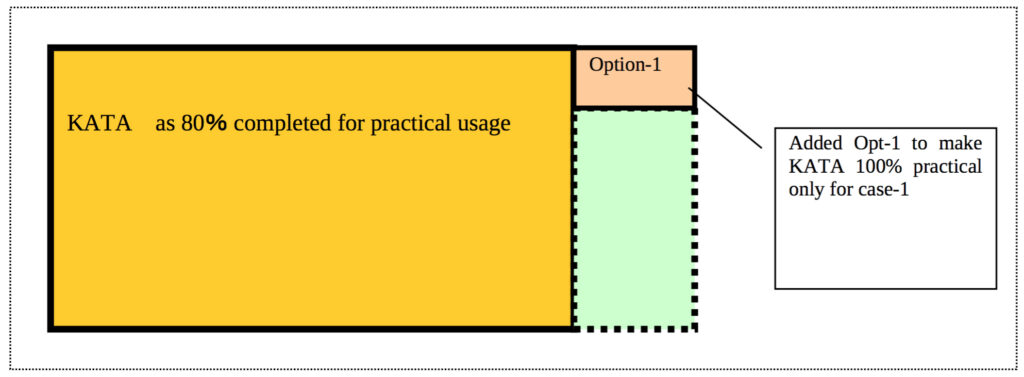
fig-2
After a while he/she can suddenly notice that it is only one case of the many which he/she found out. Because there are several other cases except for Opt-1 which are applicable, too. And he/she starts discovering several other options like fig-3 and 4.
After all, he/she can make KATA as 100% useful with the various options which he/she found out. This is the last stage which only an expert might reach.
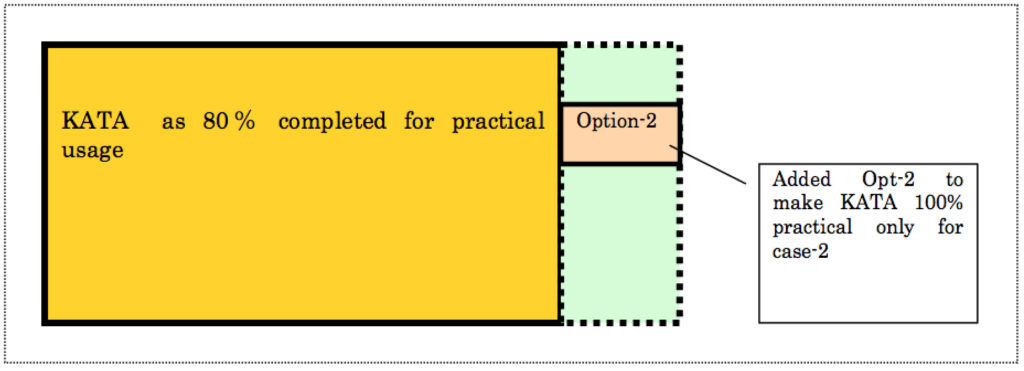
fig-3
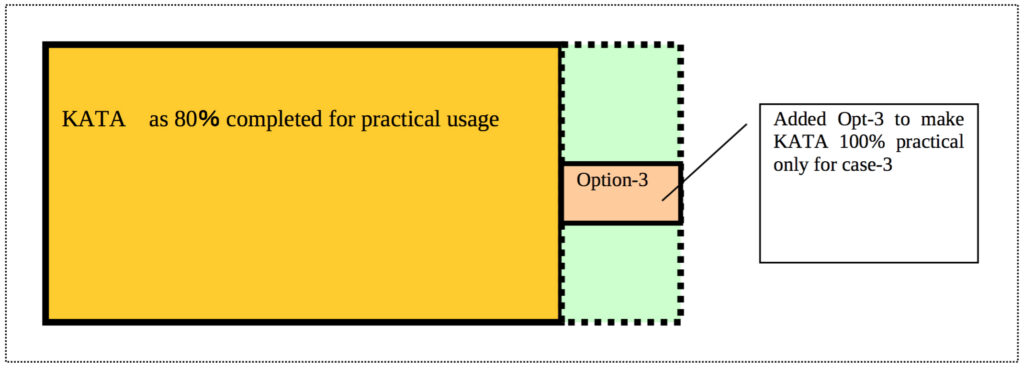
fig-4
In case someone who found out only one option is convinced that he/she could discover the very important key to make the KATA 100% complete, which the former people who practiced it could not have found, and in this way he/she gained strong confidence. Accordingly he/she fixes the KATA with his/her discovery to supplement it as in fig-5. This case often happens for the people who can’t perceive the essence of wisdom piled up for several generations of former masters and can’t notice the important background of KATA practice.
Such persons start teaching his/her student by his/her own “developed” KATA and accordingly, a lot of the possibility of the KATA is lost at that moment. Such KATA can’t be used anymore as widely as a beginner to an expert because it can’t carry a deep meaning anymore.

fig-5
Example-1: RE-9 USHIRO RYOTE KOTE SEME RENKO
Normal sequence is shown as below
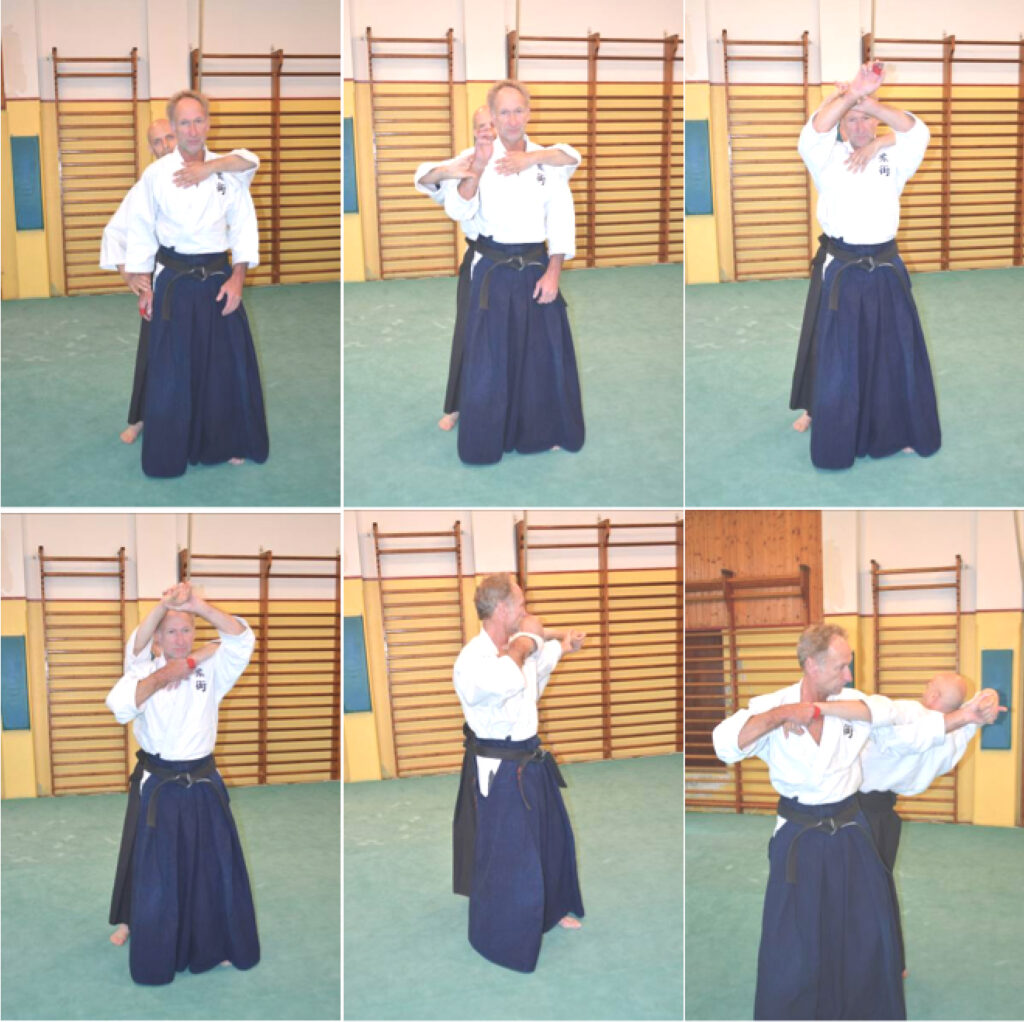
One application which my student thought of as practical to guard his throat from choking (1)
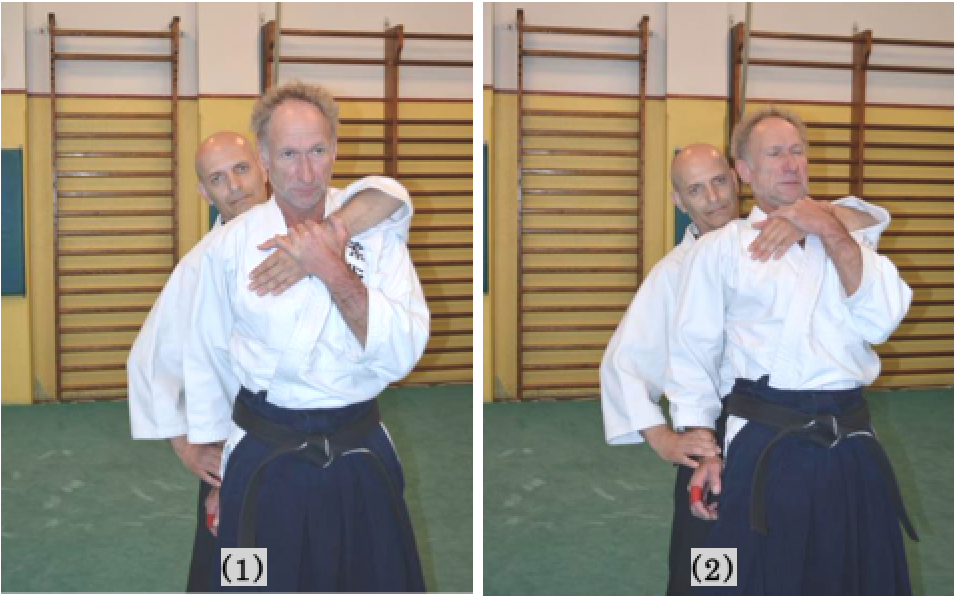
His idea is to block A’s left arm by D’s left hand to avoid being choked (1). But if A seriously pulls his left arm, it is difficult to prevent the choke. (2)
Besides, D can’t move up his right arm because of the power conflict with his left hand/arm.
The better option:
Turn his head to the right with a slight bend in the knees and at the same moment raise up the grasped right hand is the better option to avoid being choked. But if this is fixed as KATA, several other important possibilities shall be lost. But this cannot be perfect for all possibilities.
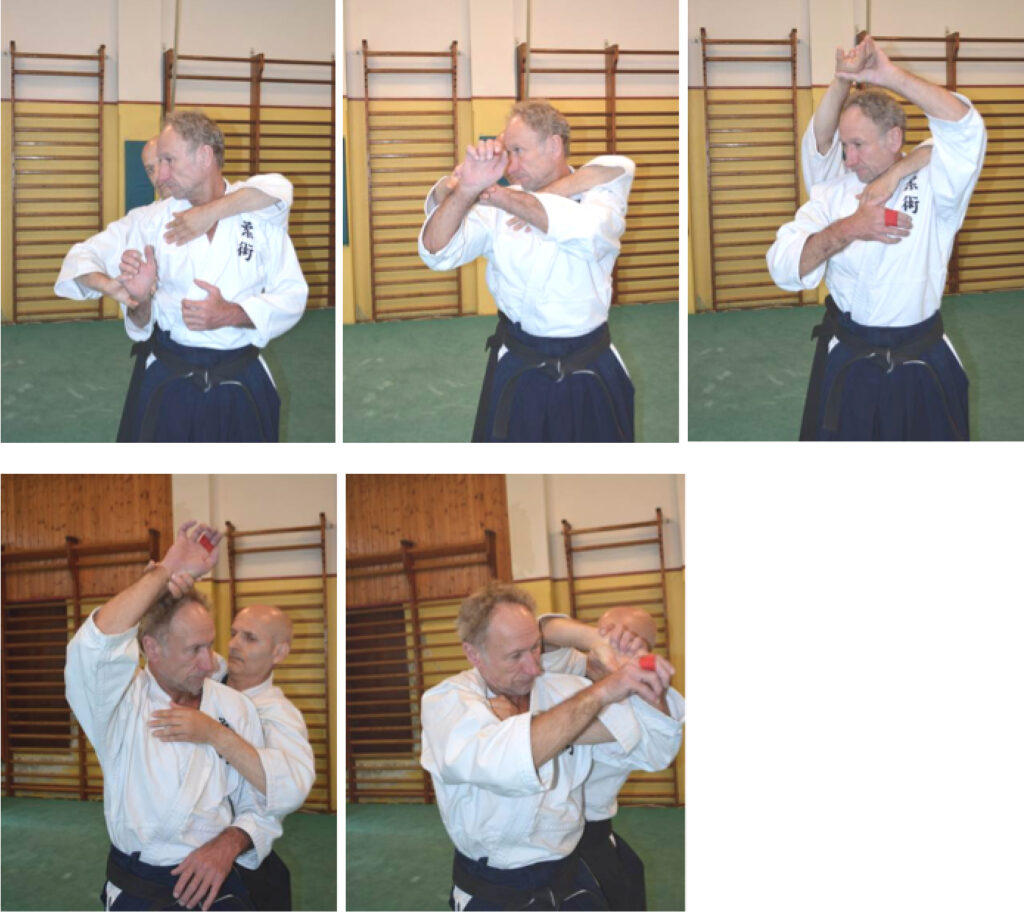
Turn head immediately to right and bend the knees down:
There is another tendency in which a beginner often makes mistakes during KATA training. Because of the same shallow thinking as described above, one can often convince themselves that he/she could improve KATA by changing it partially his own way.
As described above, KATA is an essence of several generations’ wisdom; it is itself perfect. There is no space to be improved. If somebody thinks he/she has improved KATA by changing it, it is no doubt worse. In such a case, the KATA meaning became so small and limited as illustrated in fig-6.

fig-6
Example 2: NU-8 BUKKOTSU SEME NUKIMI
Here is shown a wrong example. Instead of making Y-Block, use open fingers which one of my student thought as much easier and practical way, shall not work against a person who has a thick neck. This kind of person is probably strong and dangerous to fight against. So, this is not an improvement, but just a degradation of the KATA.

Correct shape
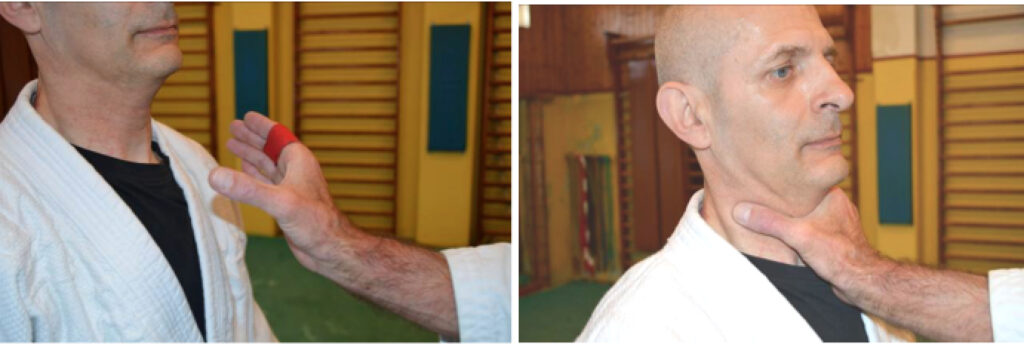
Wrong shape which might not work for a person with a thick neck
I believe in this way a lot of important know-how might have been lost in European JUJUTSU for the past century without a proper Japanese teacher.
5.3b How to find a real JUJUTSU Teacher
When one intends to learn JUJUTSU, the first thing he/she should do is to find a proper teacher. This looks rather easy because there are plenty of JUJUTSU masters around him/her. But it is actually quite difficult to find a proper teacher. There is a problem of finding a real JUJUTSU master — by this I mean a master who can teach real, traditional, Japanese JUJUTSU which is grounded in a lot of know-how. In Europe where I had lived for the past 27 years, many people learn either (a) a style that has no connection with real JUJUTSU or (b) a martial art with a thin connection with real JUJUTSU from the past. The former (a) is not JUJUTSU at all. It is usually a collection of brutal techniques from JUDO and KARATE.
This combination was created by people without any proper concept nor knowledge of real JUJUTSU and I regret I see too many such self-naming JUJUTSU masters in Europe. It should not be called JUJUTSU. One can easily recognize this kind of fake JUJUTSU by watching its CHUDAN TSUKI (hit). In case they use KARATE’s TSUKI instead of JUJUTSU TSUKI which is called ATEMI, what they teach is not JUJUTSU. It is fake JUJUTSU. There is no doubt about this.
The latter case (b) still carries real JUJUTSU “flavor,” but unfortunately, most of the deep know-how has been lost due to unnecessary changes created by non-Japanese teachers over the generations, or simply the important know-how was not transferred at the beginning.
There is an easy way to check if the teacher can teach real JUJUTSU with the necessary know-how. The teacher should be able to perform one technique called UDE SANKAKU SEME RENKO, or it is often called as HICHIRI BIKI. In Japan, every qualified JUJUTSU teachers instruct this technique in a collect way. But out of Japan or sometimes even in Japan a “master” who did not receive a proper instruction but just copied the technique from Youtube etc. performs unproper way as just attack the opponent’s elbow joint by force.
Ude Sankaku Seme Renko or Hichiri Hiki (腕三角責め連行、七里引き)
Ude Sankaku Seme Renko is also a very essential Jujutsu technique which is contained in almost all Jujutsu Ryuha (styles). It is also called as Hichiri Hiki which means “arrest for seven miles”. So by using this technique one can control another and bring him along for even seven miles. But, the same as with the other such techniques it is seldom performed correctly by non-Japanese, or even some Japanese Jujutsu people. Because of their incorrect technique, they could never bring the other for even 100 meters. Hereunder I explain its know-how.
How it is performed by many people (The last Kime, or lock, is not the proper way)
There are many different ways to enter into this technique, so please focus only on the way the last Kime (lock) is done.

Fig-1 Uke grasps Tori’s left wrist by his left hand
Fig-2 Tori holds the back of Uke’s left wrist and pulls it backwards while performing Shuto Ate to his Waki Hara (side of the torso) using his right hand
Fig-3 Tori wraps his right arm over Uke’s left upper arm
Fig-4 Tori controls Uke by reversing the direction of the elbow joint and locking it. They often put the right hand onto the left lower arm to strengthen their elbow pushing power. So, this last Kime is wrong and the correct Kime is shown by Fig-5
Fig-5 This is the correct Kime, or lock. Please compare with Fig-4. The clear difference is Uke stands up on their toes because of the pain, but in Fig-4, they do not.
Using this lock, Tori arrests Uke while keeping this Kime (control) and takes several steps.
How to control the other
In almost all the cases shown on Youtube, Tori pushes Uke’s elbow joint reversely to control Uke, which is not correct. Although it causes Uke’s elbow enough pain, it does not cause sharp enough pain to arrest, or escort him for seven miles. We can recognise the wrong case very easily because in most cases they place their other arm under the controlling arm so that they can push Uke’s elbow stronger, as shown by Fig-4.
The point to be targeted in this technique is not elbow, but a Kyusho (weak point) just behind the end of the upper arm (triceps muscle), close to shoulder. You can search for this Kyusho point yourself, as shown in Fig-6,7.
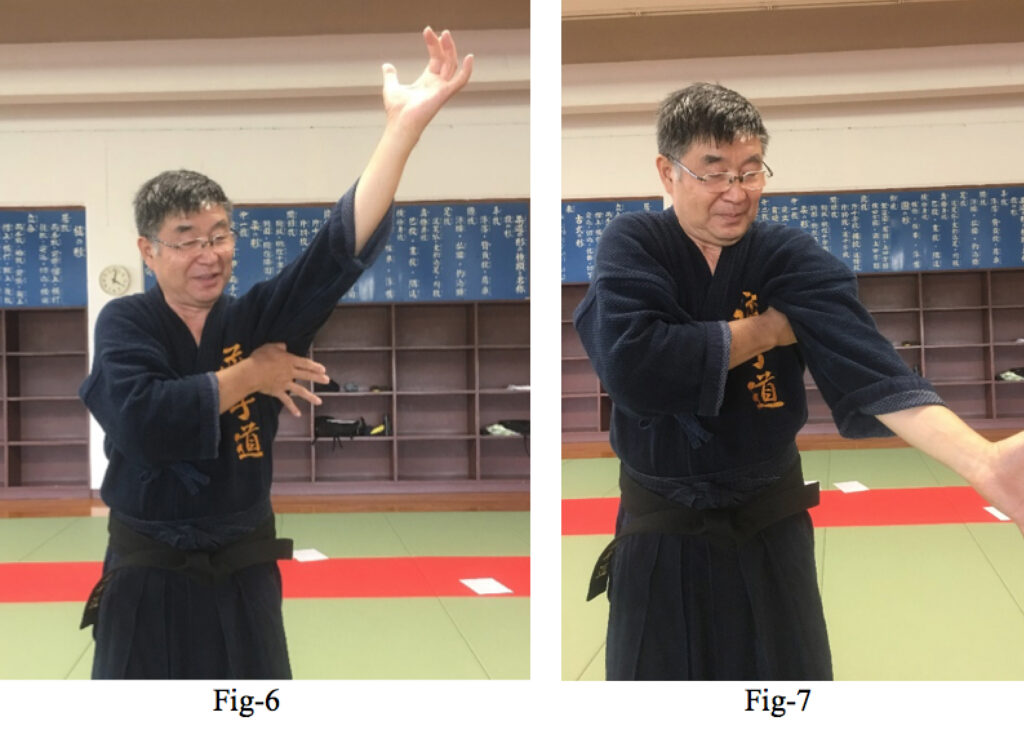
If the right hand is put on the Kyusho point, the left arm cannot move down any further because of the pain caused at this Kyusho point.
So, Tori should put his lower arm as deep as possible (toward Uke’s shoulder) so that the edge of his lower arm (forearm) touches this Kyusho point, and pressing on this Kyusho point by lowering his arm, Uke receives quite sharp pain.
5.4. Corresponding course of Gyakute-do
Since Jan. 2012, as a pilot trial, a corresponding course of GYAKUTE-DO has been started, aiming to establish an innovational, efficient, and practical corresponding JUJUTSU teaching method which many other similar attempts could not succeed in the past.
Thanks to the motivated branch members who joined, a remarkable progress has been made with the result of 7 new black belt holders as of now. Accordingly, it is decided to start formal corresponding course as of 1st November 2016 with the fully opened door to all over the world.
Till now we established total 8 corresponding course branches and existing branches are 6 as
(1) Two in Japan Kitami, Matsuyama 日
(2) One in Indonesia Jakarta,
(3) Two in Poland Warsaw
Besides, based on this success, I have started another challenge to teach AIKI JUTSU by corresponding course. It is already difficult enough to teach JUJUTSU by corresponding course, but regarding AIKI JUTSU, nobody has ever even tried it in the past. A lot of people spend several, or even more than 10 years learning AIKI JUTSU with certain teachers and most of them abandon their study without mastering it.
So, I have established the 2 corresponding courses of GYAKUTE-DO JUJUTSU/AIKI JUJUTSU and AIKI JUTSU. Please visit the FaceBook Aiki Jujutsu Gyakutedo
Material to learn GYAKUTE-DO in addition to this book :
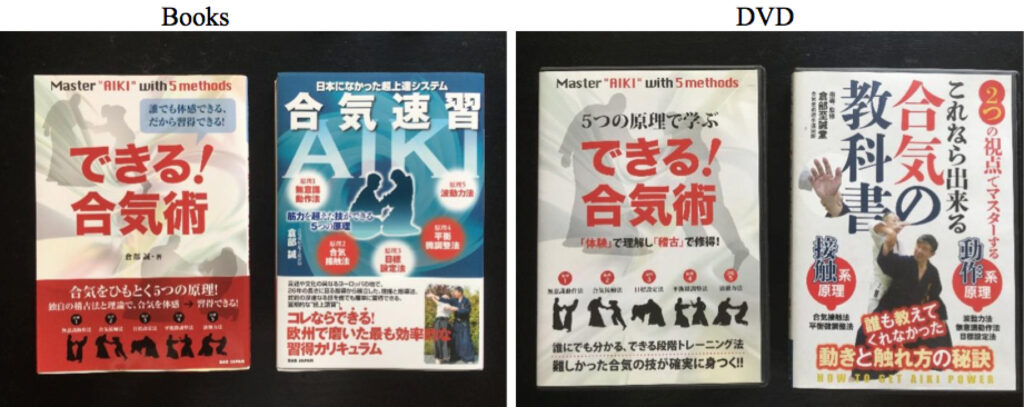 Both available by Amazon or order directly to BAB Japan at Budo Japan (Budojapan.com)
Both available by Amazon or order directly to BAB Japan at Budo Japan (Budojapan.com)
The third book will be published in November 2020 by BAB Japan.
Also below AIKI book in English is available on order base.

5.5 Organization of Gyakute-Do 逆手道の組織
1. Head Quarter 総本部道場
(1) General Head Quarter and Dojo 総本部及び道場
Grand Master 2nd SOUSHI KURABE SHISEIDO 倉部至誠堂 第二代逆手道宗師
Location: 5-18-12 Sakasai Kashiwa Chiba 277-0042 Japan tel: +81 80 9157 1192
277-0042 千葉県柏市逆井5丁目18番12 電話:080-9157-1192
Practising day/time : Any day 10:00-17:00 required reservation in forehand
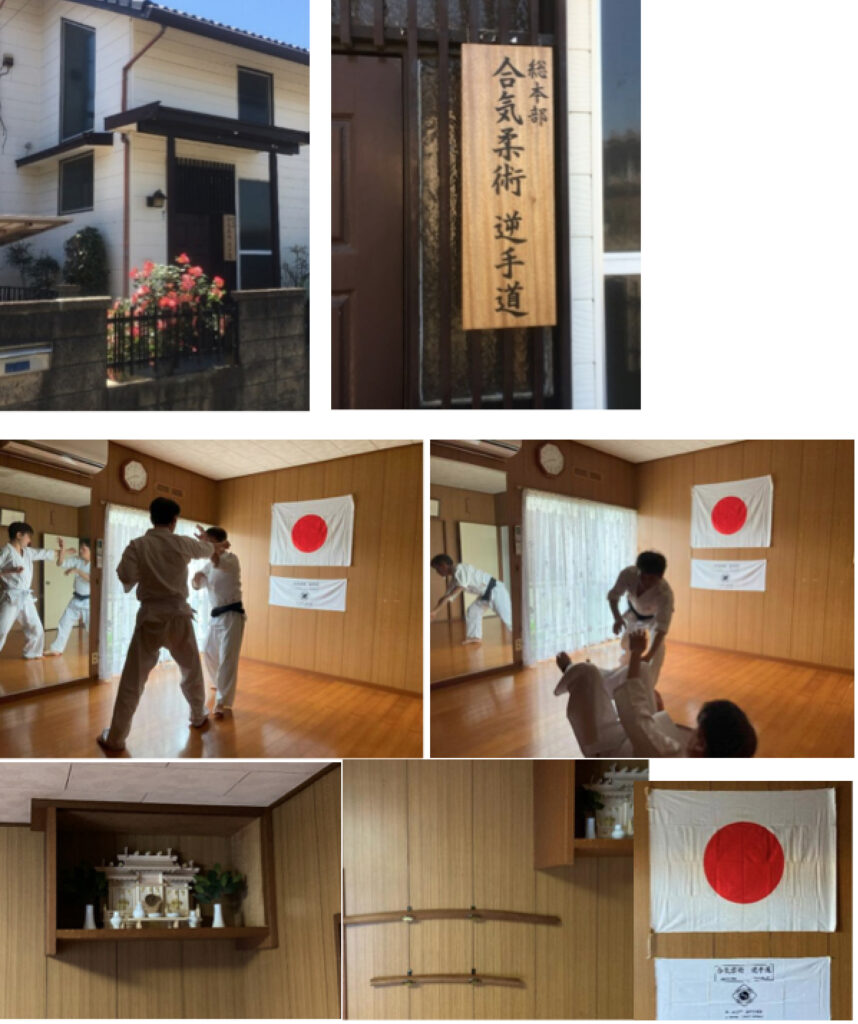
(2) 柏本部道場 Kashiwa Honbu Dojo
指導者:岡部武央第四代宗師
Instructor: Takehisa OKABE 4th Soushi
Location: 柏市中央体育館 Kashiwa Central Public Sports Center
Day/time: Every Tuesday afternoon 15:00-17:00

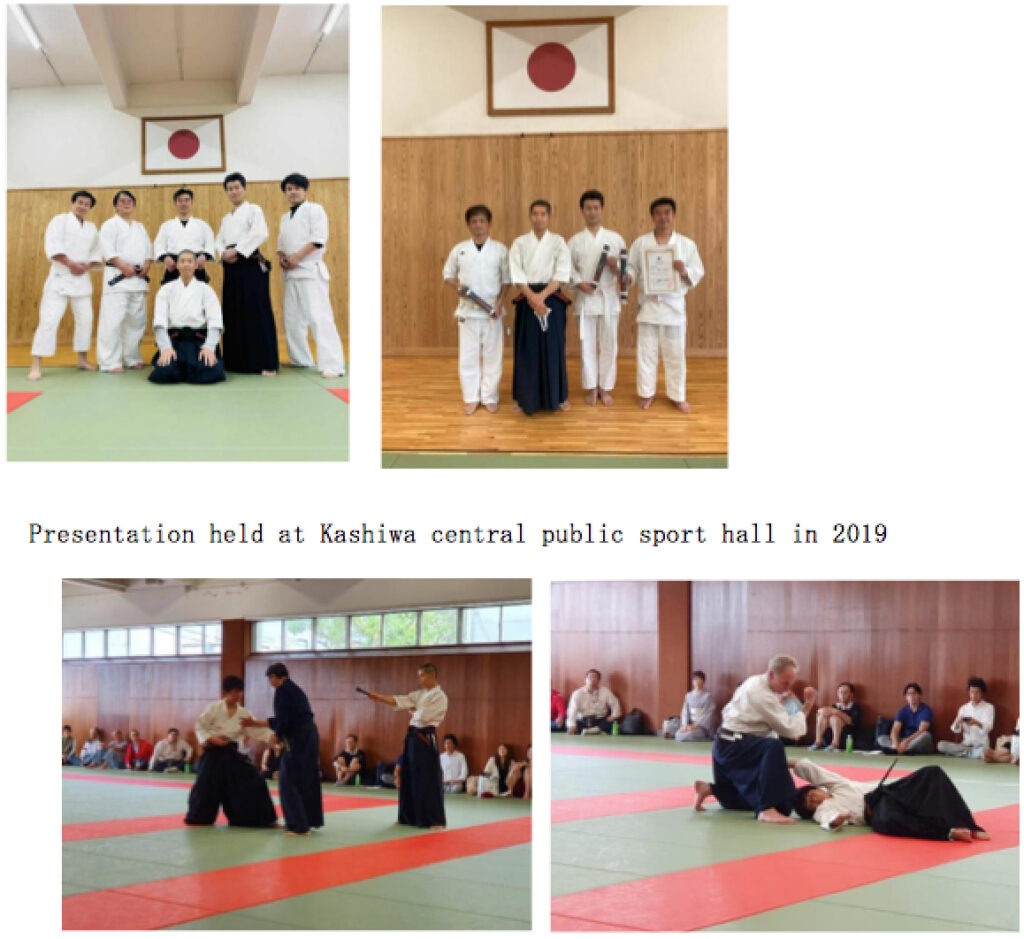
(3) European Head Quarter 欧州本部
Grand Master: Steve van Nieuwenhuizen 3rd SOUSHI 10th DAN, NAKONI-RYU Jujutsu SOUKE
Sub Representative: Theo Philips SHIHAN 6th DAN
The Hague Head Quarter Dojo:デン・ハーグ欧州本部道場
Normal Course: every Thursday evening from 9:00-10:30
Instructor: Steve van Nieuwenhuizen Gyakute-do 3rd SOUSHI 10th DAN
Assistant Instructor: Sander Martens SHIHAN-DAI 4th Dan
Location :Sportacademy Groot Hertoginnelaan 169, 2517 ER Den Haag Tel : 070 345 80 90
Website www.jiujitsujudodenhaag.nl
www.nakoni-ryu.nl
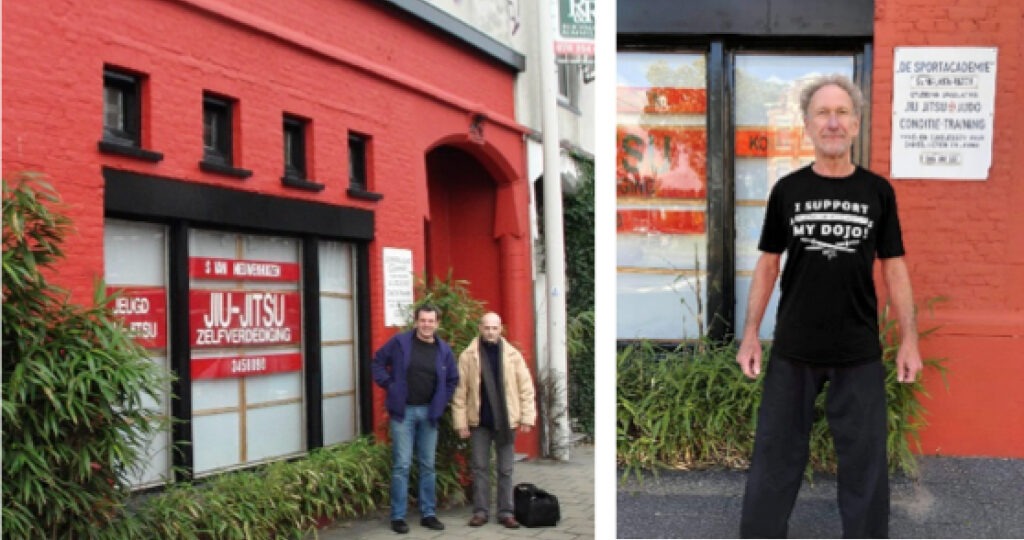
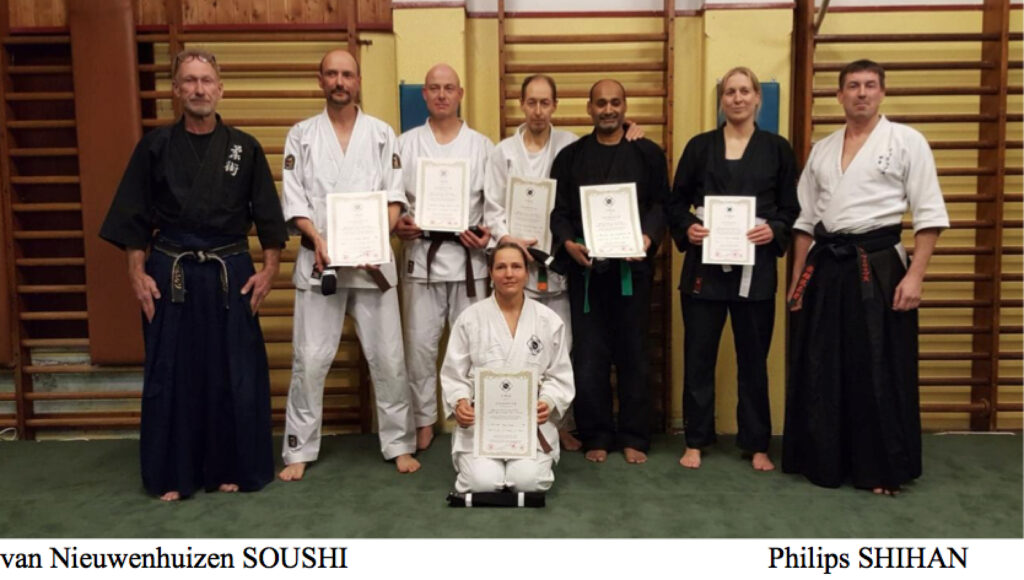
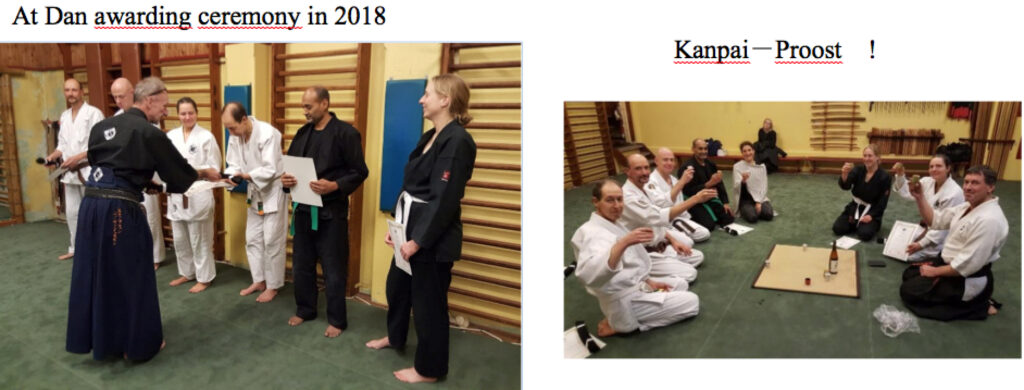
2. Branch Dojo in Japan 支部道場(日本)
(1) Matsuyama Branch 愛媛県松山支部
Instructor: Shinji OHIZUMI 大泉真二 Principal SHIHAN 7th Dan 主席師範七段位
Assistant Instructor: Yasuhiko MURAMARU 村丸康彦 3rd Dan 三段位
: Kouji WADA 和田幸司 3rd Dan 三段位
Location: 2-29 Koromoyama Matsuyama city Ehime Prefectur
Practising day/time Every Wednesday 19:00-21:00
Contact: telephone +81 (0)90-6883-3499(OHIZUMI)
Mail Address: kakurekumanomi@mc.pikara.ne.jp
Home Page: http://www.gyakutedo.org
(2) Ohotsuk (Kitami) branch 北海道オホーツク(北見)支部
 Representative Akihiko AZUMA 3rd Dan 東明彦 三段位
Representative Akihiko AZUMA 3rd Dan 東明彦 三段位
Instructor: Hiroyuki UEMATSU Shihan 5th Dan 植松宏行 師範伍段位
Location: 270-2 Koizumi Kitami city Hokkaido 090-0001
Practising day/time Every Monday, Saturday, Sunday AM 10:00-12:00
Contact Telephone +81 (0)157 24 6861,
Mail amadeus.jjj@gmail.com (UEMATSU)
Telephone +81(0)186 76 054,
Mail abaki1967@gmail.com (AZUMA)
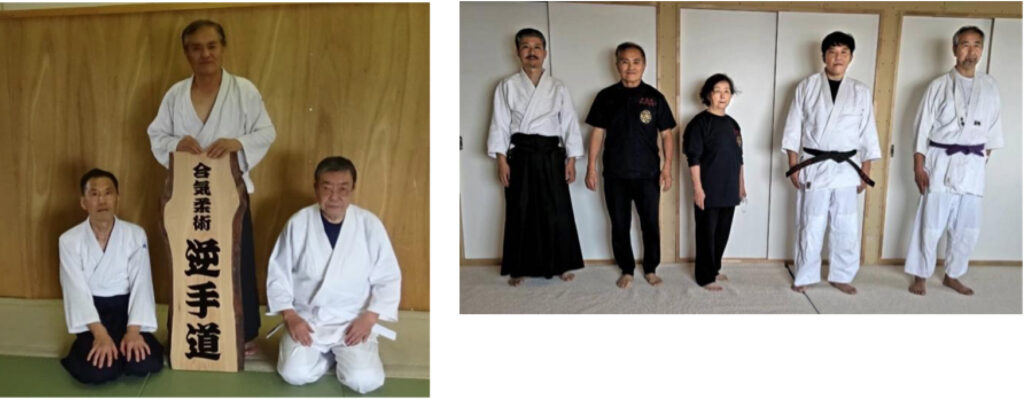
3. Foregin branch 海外支部
(1) Poland Warsaw branch ポーランド ワルシャワ支部
Representative: Przemysław Antczak SHIHAN 6th Dan
Assistant: Michał Świderek SHIHAN-DAI 4th Dan
Marek Wierzbicki 3rd Dan
Class Time: Wednesday 19:30 -20:30
Location: Wokalna 1 Warsaw Poland
Telephone: +48 515 269 315
E-mail: Office@tenshinkai.pl
Website: www.tenshinkai.pl
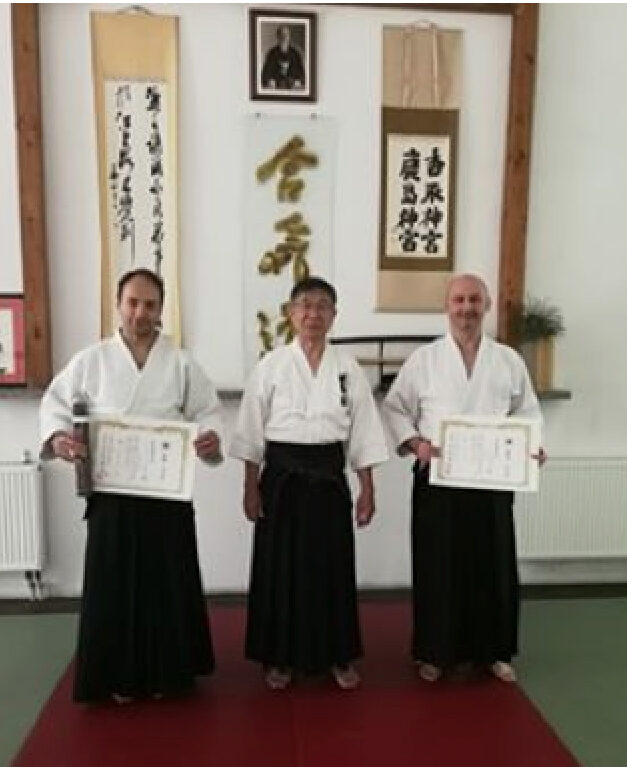
Antczak SHIHAN, Kurabe SOUSHI and Świderek SHIHAN-DAI
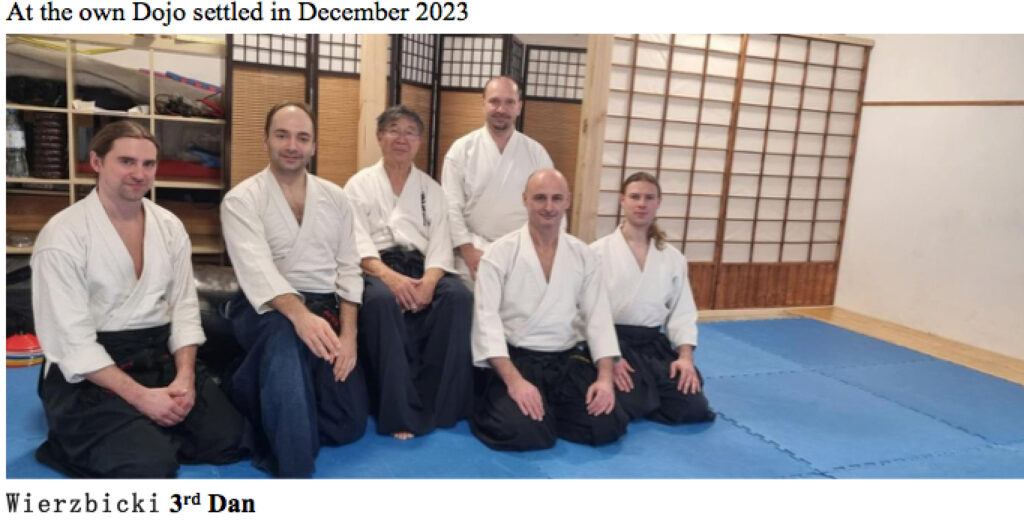
(2) Nedrland Utrecht branch オランダ ユトレヒト支部
 Instructor: Theo Philips, Gyakute-do SHIHAN 6th Dan
Instructor: Theo Philips, Gyakute-do SHIHAN 6th Dan
Assistant Instructor:
every 2nd Friday evening PM 8:30-10:00
Location: Kempo Bushido Dojo, Utrecht
E-mail info@kempo-bushido.nl
Website www.kempo-bushido.nl
left: Theo-SHIHAN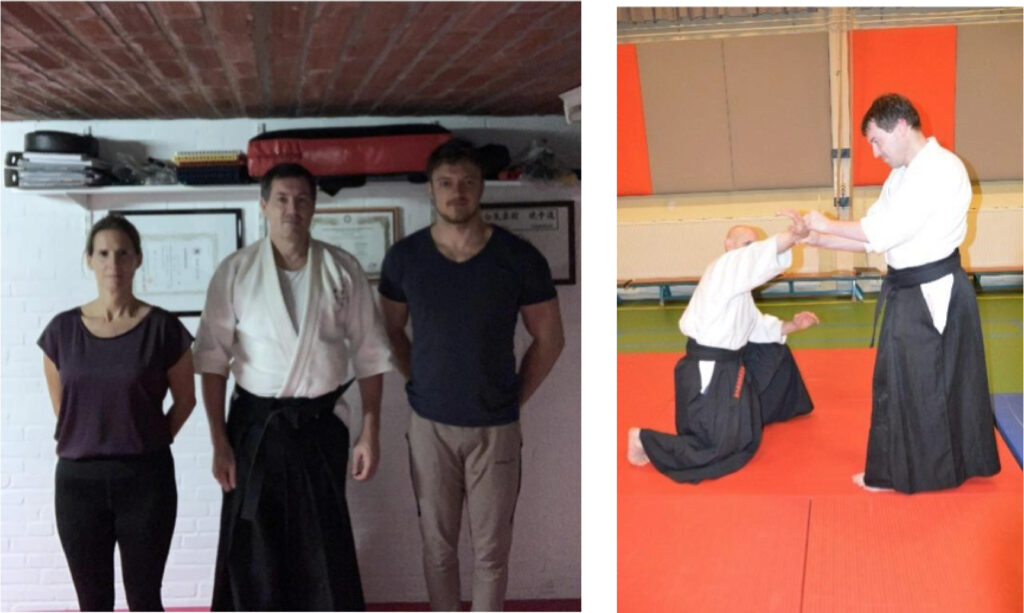
(3) Poland Bydgoszcz branch ポーランド ビドゴシチ支部
Representative: Jarosław Paradowski SHIHAN-DAI 4th Dan
Assistant Instructor: Rafał Paradowski 2nd Dan
Class Time: Every Friday at 4 p.m.
Location: Okulickiego 1 m 9 Bydgoszcz 85-791 POLAND
Telephone: +48605030032
E-mail : jaroslawp4@gmail.com
Website : under construction
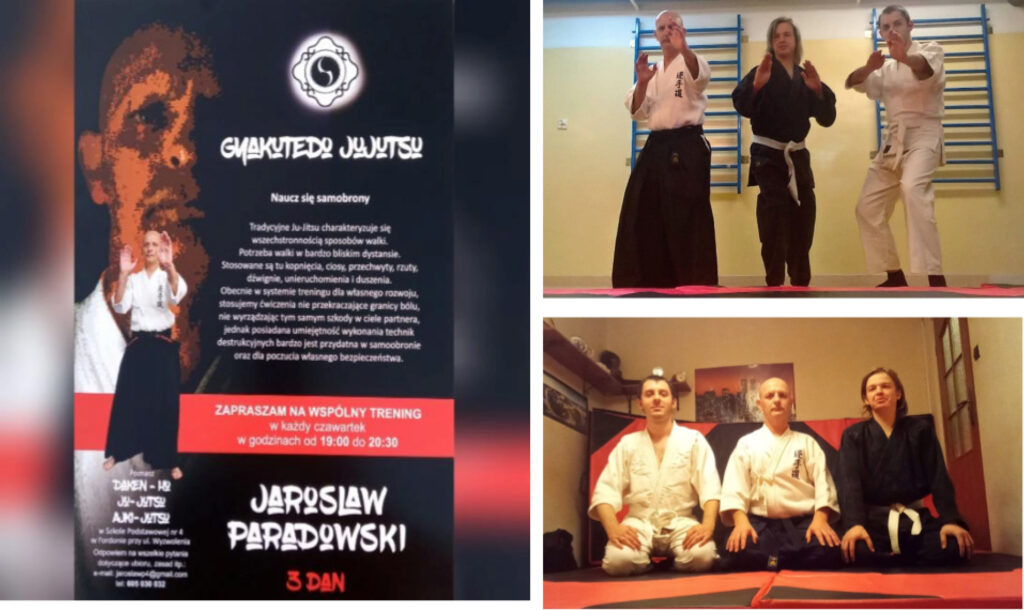
(4) Indonesia Jakarta branch: インドネシア ジャカルタ支部
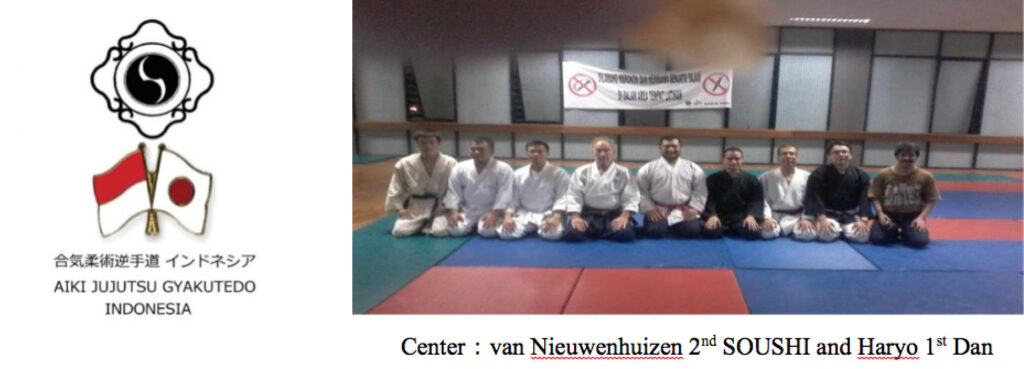
Representative: Ben HARYO 1st Dan, Wado-ryu Karate 5th Dan, Dento-kan Jujutsu Shihan 5th Dan
Telephone: +62-817-6908796
E-mail: gbi_club@yahoo.com
Website: https://sites.google.com/site/gbiclub/home/gyakute-do
Dojo #1: Dojo Kebon Sirih (at Bank Capital)
Address: Gedung Grand Kebon Sirih, 1st Floor, Jalan Kebon Sirih No.35, Jakarta Pusat, Indonesia.
Schedule: every Thursday evening.
Dojo #2: Dojo Cempaka Putih
Address: Gelanggang Olahraga Cempaka Putih, 3rd Floor, Jalan Cempaka
Putih Tengah 31 No 3, Jakarta Pusat, Indonesia
Schedule: every Saturday afternoon.


Wrote & supervised by KURABE Makoto SHISEIDO, 2nd Soushi (Grand master) of AIKI Jujutsu Gyakute-do
He was born in 1950 in Kashiwa city Chiba prefecture. Graduated PHD course of Science University of Tokyo. After learning Judo and Shito-ryu Karate-do, started learning Gyakute-do Jujutsu which was created under influence of Hakko-ryu Jujutsu and the other Ko Bujutsu. Since TANAKA Tadashi CHUSHUDO, founder of Gyakute-do, 1st Soushi, passed away and the Ryuha died out without a successor, he had started instructing Gyakute-do seriously to the local Budo fans in the Netherlands so that he can let the name Gyakute-do would not disappear. Besides, during pursuing Gyakute-do, he had discovered the theory of AIKI and had established the methods to realize AIKI and the practicing way in his original way successfully.
Time to time he often writes for the Japanese martial arts journal “Hiden”. So far he has published books “Theory of Vibration Modal Analysis”, “Story of Dutch”, “Fast learning AIKI”, etc., DVDs “How to master AIKI” etc.
Learn AIKI by a Combination of
Videos and Articles!!
» At the starting of AIKI Web Course
with Videos and Free Articles
AIKI Web Course Part 2 24 Lessons
-
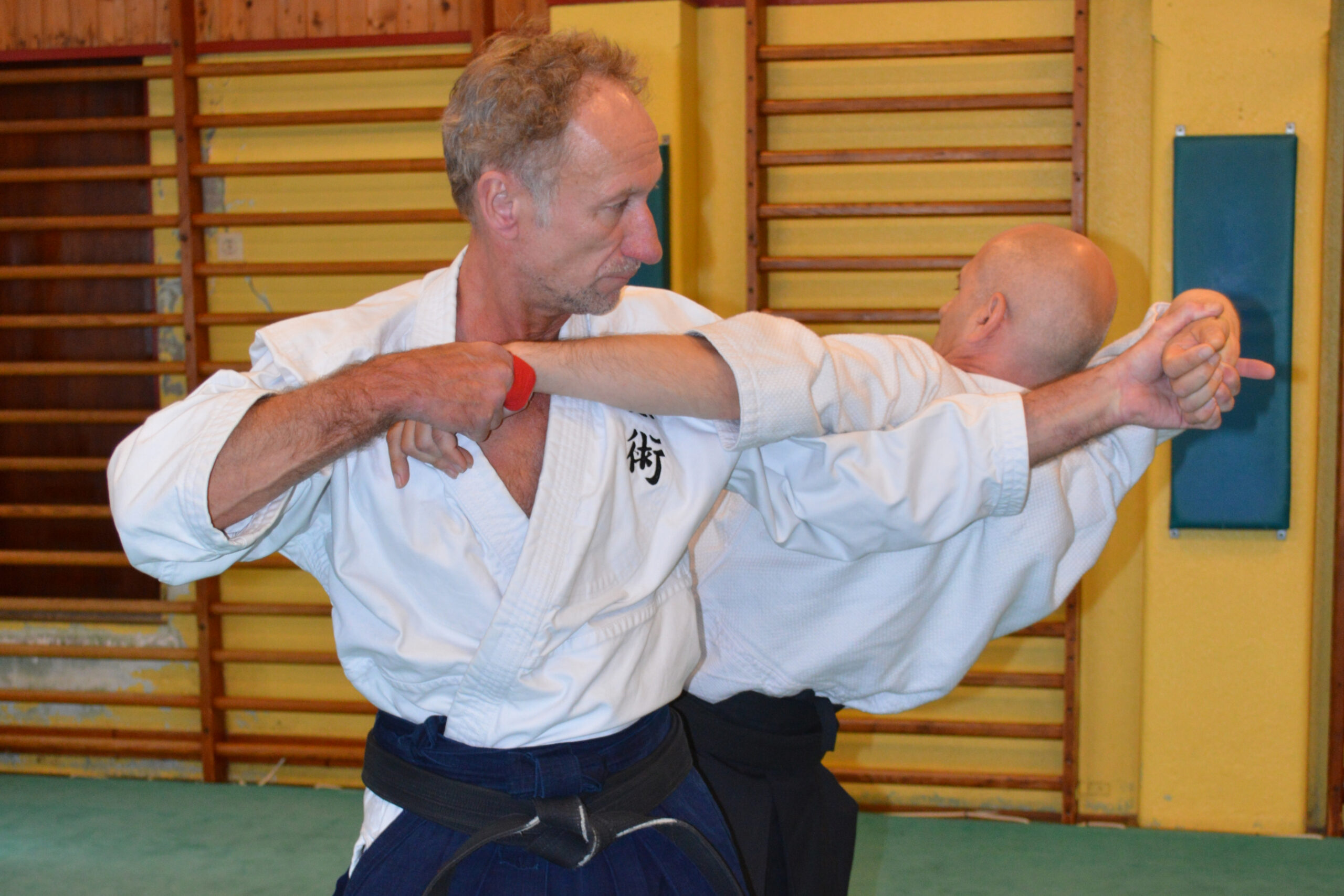
【AIKI JUJUTSU GYAKUTE-DO Series No.5】How you can learn Jujutsu properly
-

【AIKI JUJUTSU GYAKUTE-DO Series No.4】DAKEN-HO Hit and Kick KATA and AIKI
-
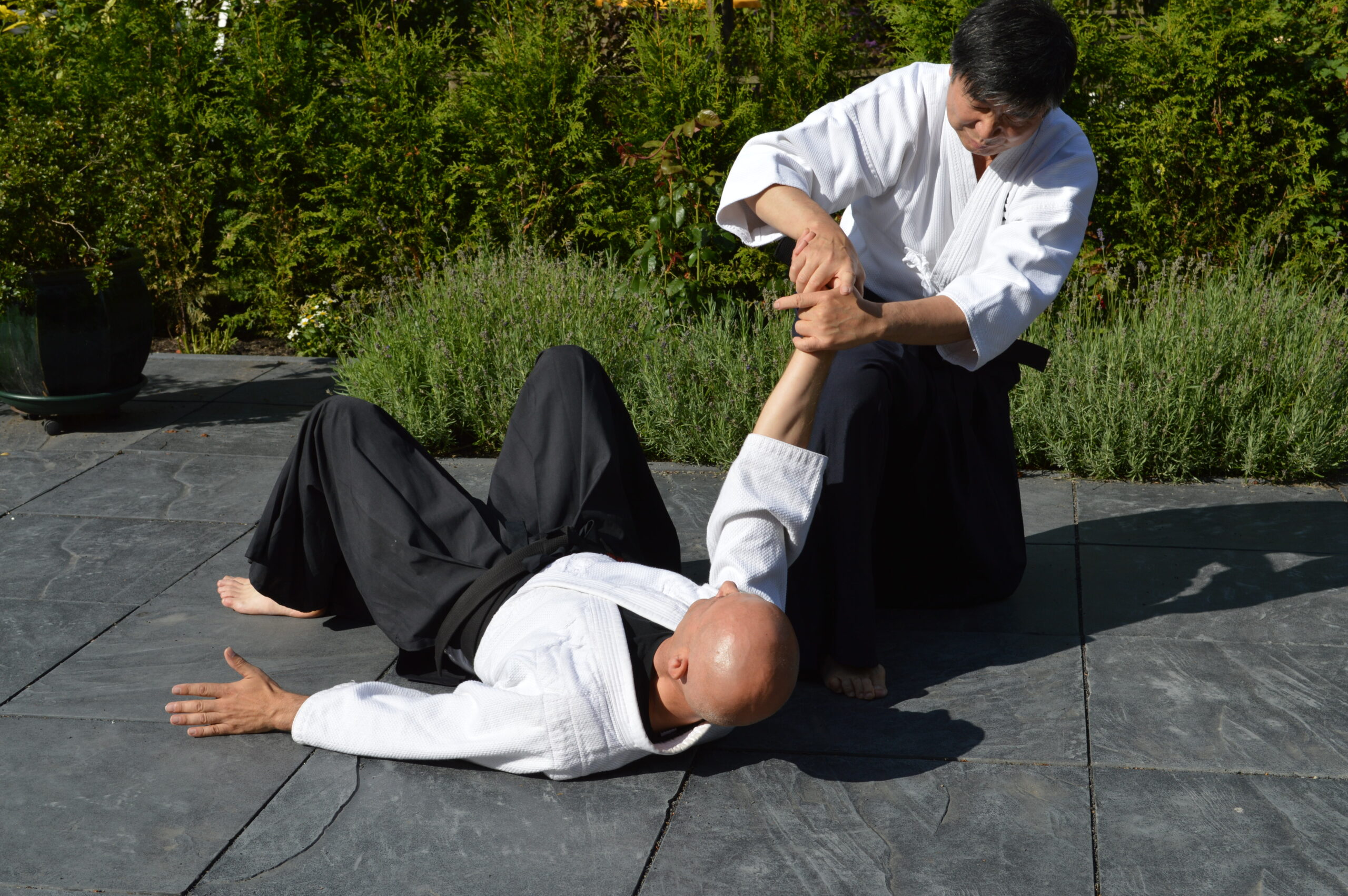
【AIKI JUJUTSU GYAKUTE-DO Series No.3】JUJUTSU WAZA, digest of FUDO
-
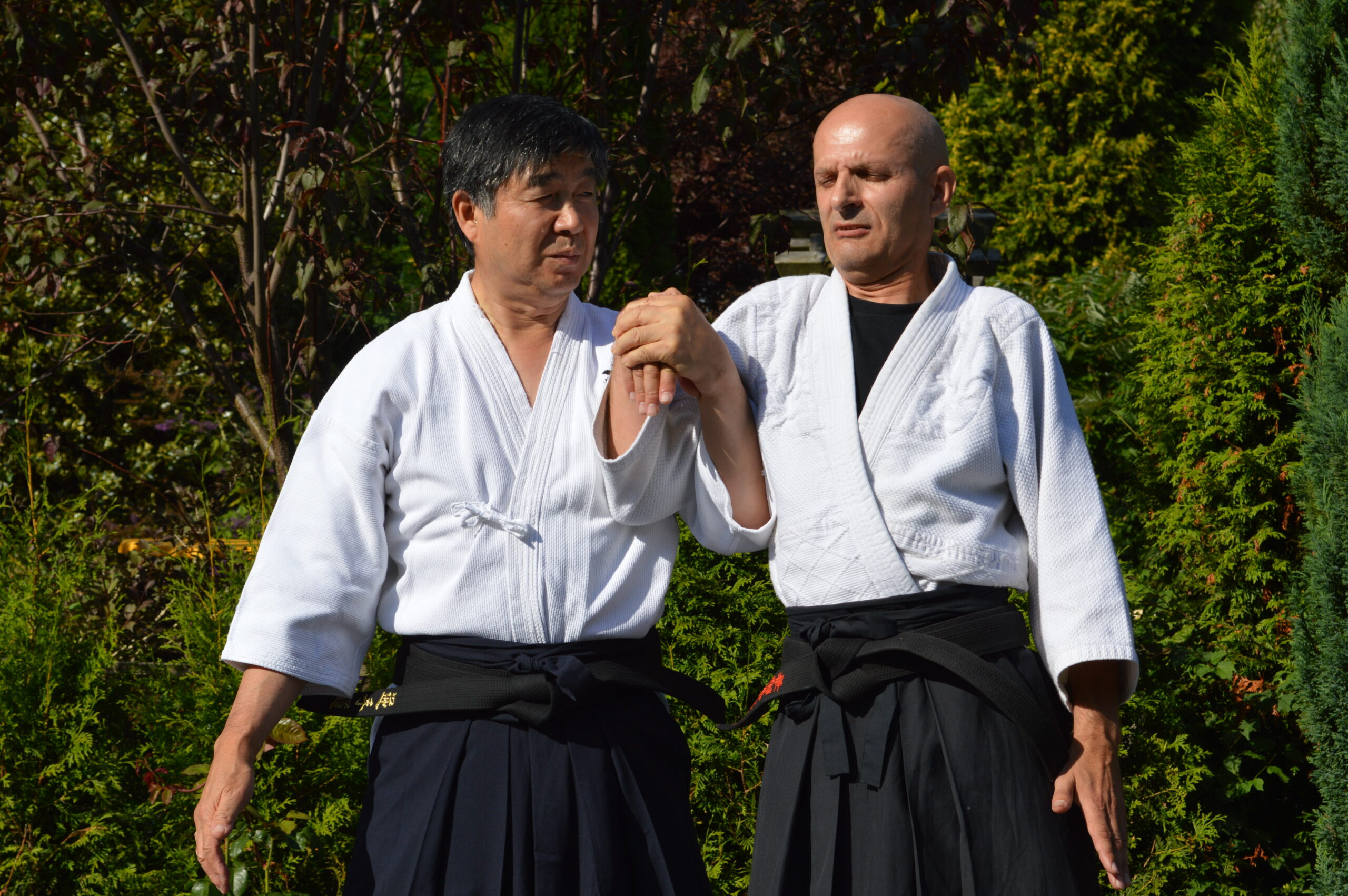
【AIKI JUJUTSU GYAKUTE-DO Series No.2】JUJUTSU WAZA, digest of NUKI, RENKO and NAGE
-

【AIKI JUJUTSU GYAKUTE-DO Series No.1】About GYAKUTE-DO and the digest of its basic techniques
-
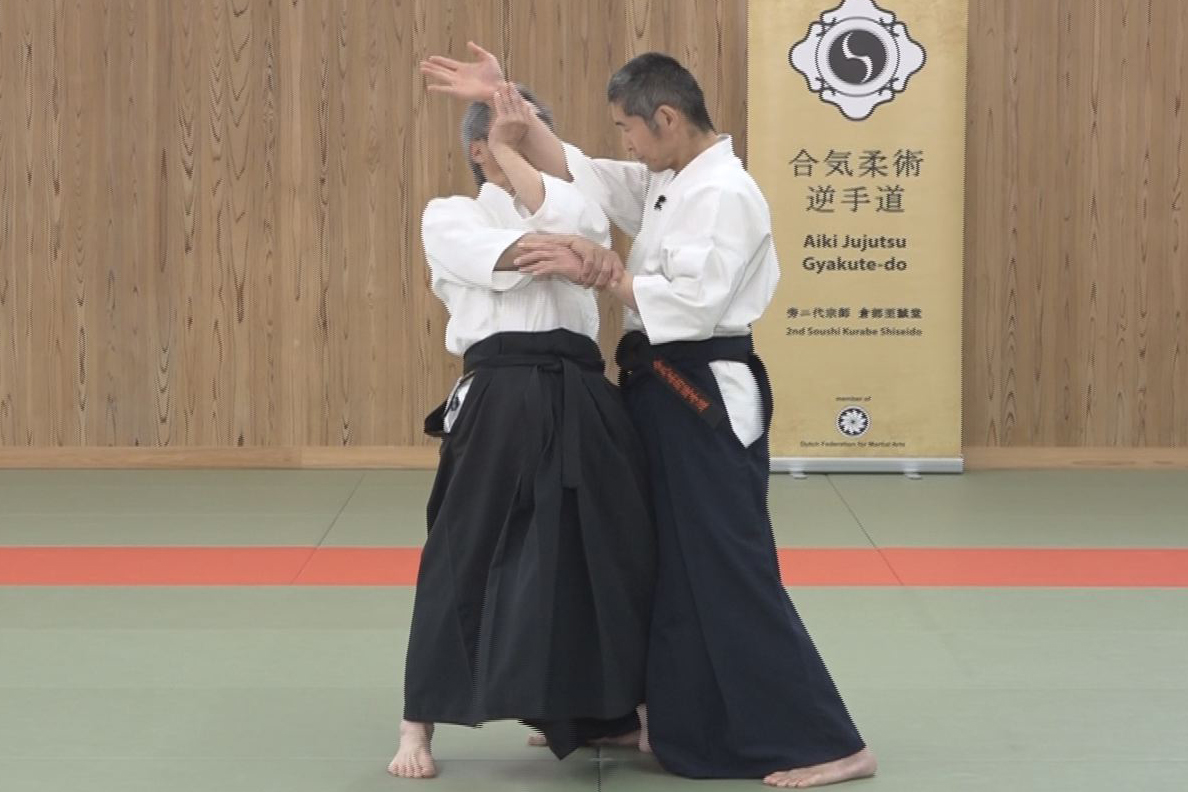
Lesson 24 With Comb. of Different Methods #2
-
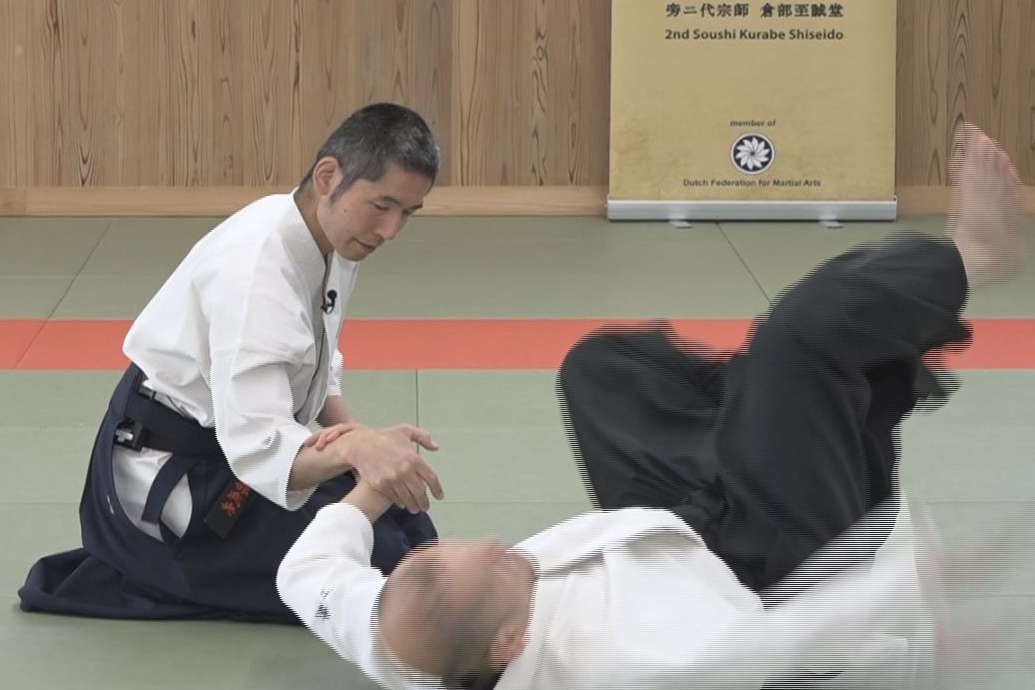
Lesson 23 With Comb. of Different Methods #1
-

Lesson 22 Advanced Tech. using F. E. method #2
-

Lesson 21 Advanced Tech. using F. E. method #1
-
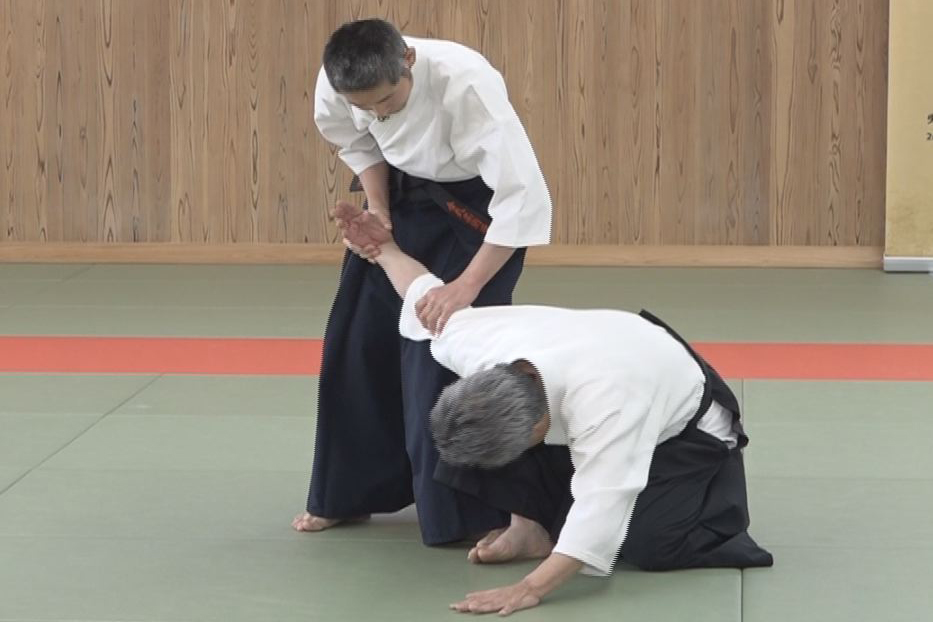
Lesson 20 Advanced tech. using T. F. T. #2
-
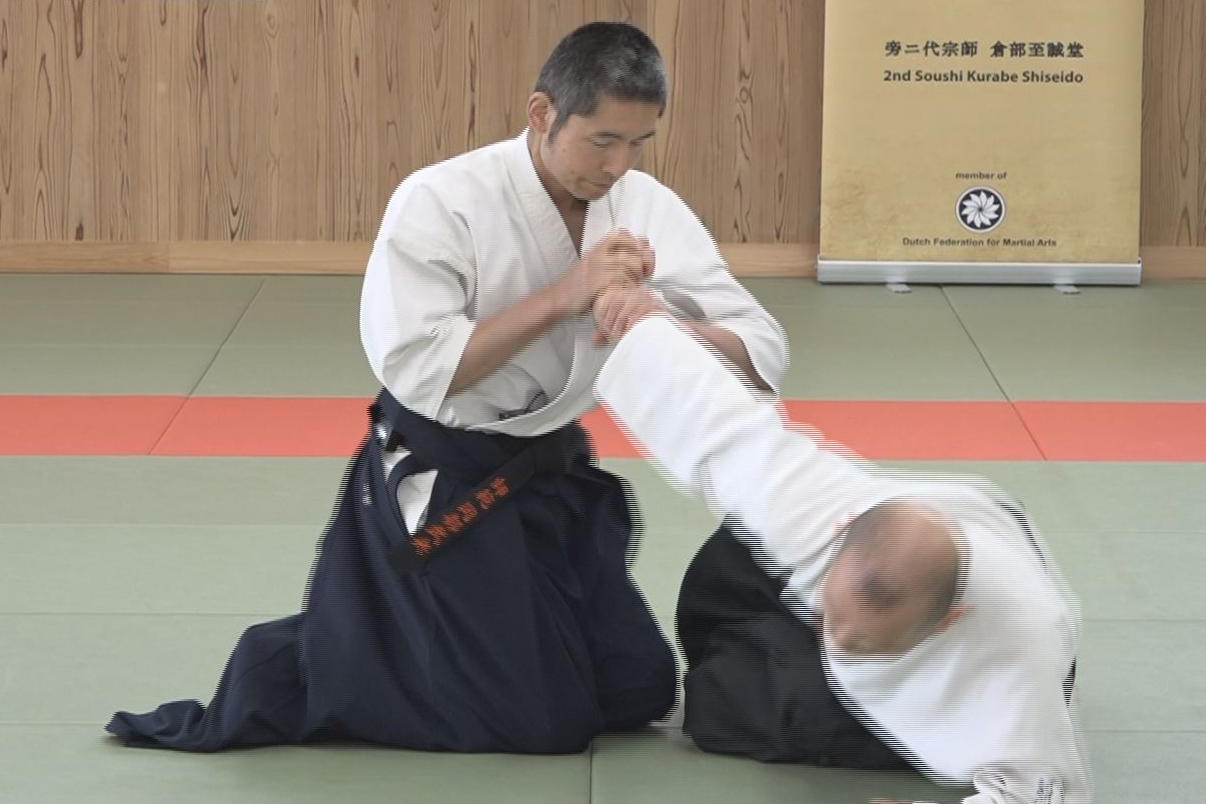
Lesson 19 Advanced tech. using T. F. T. #1
-
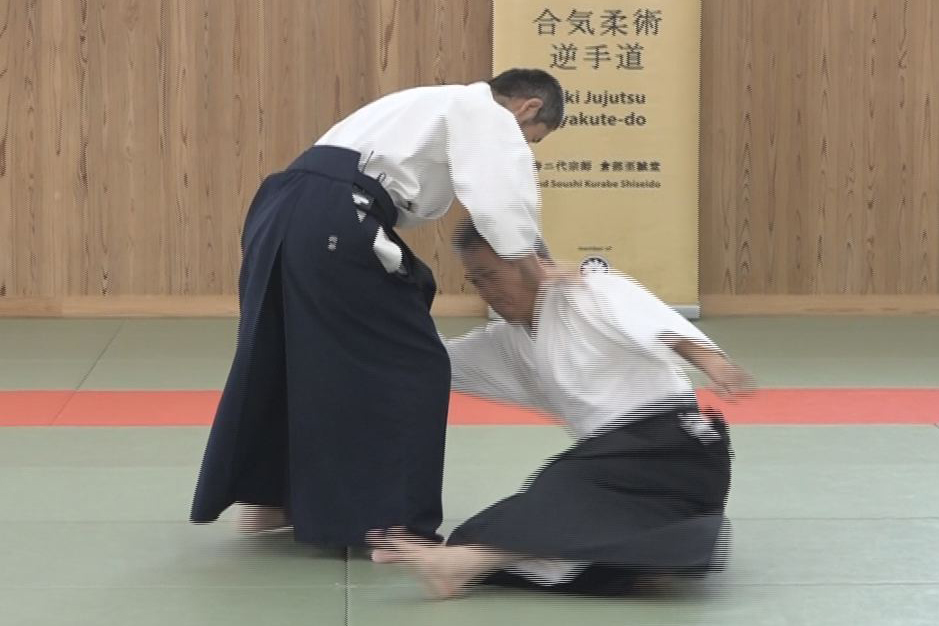
Lesson 18 Advanced tech. using AIKI Contact #2
-
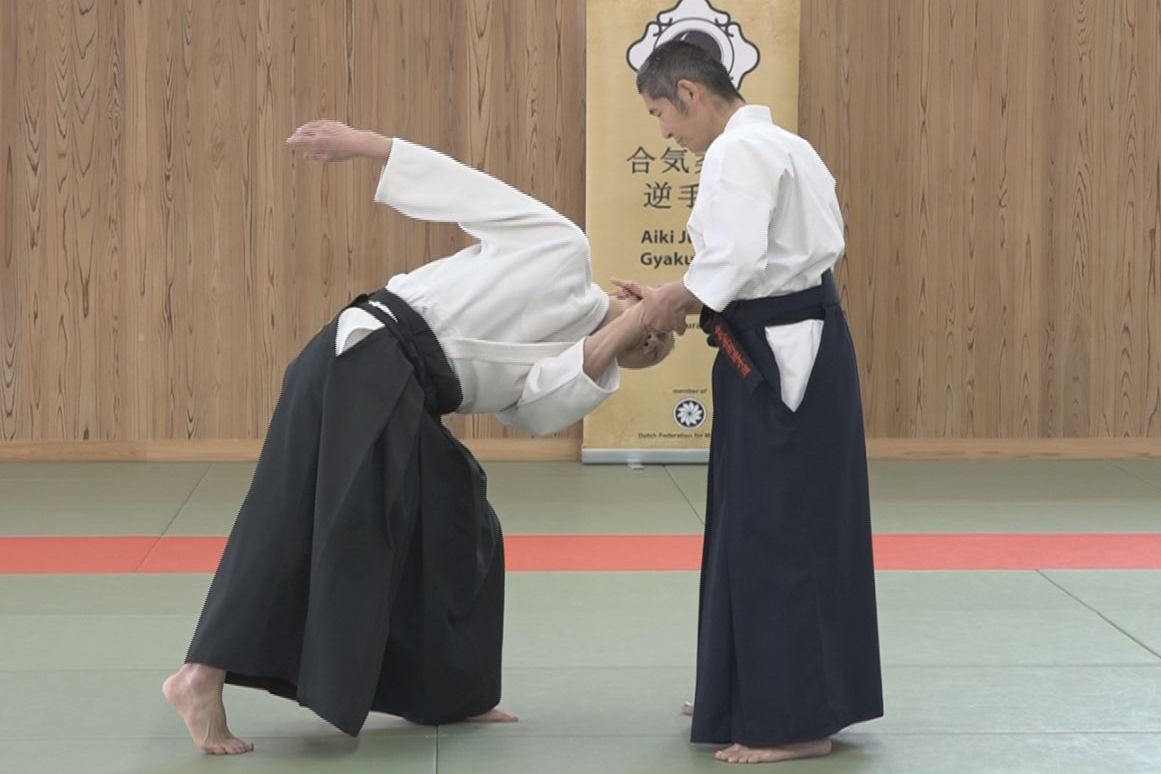
Lesson 17 Advanced tech. using AIKI Contact #1
-

Lesson 16 Advanced tech. by Undetectable F.T. #2
-
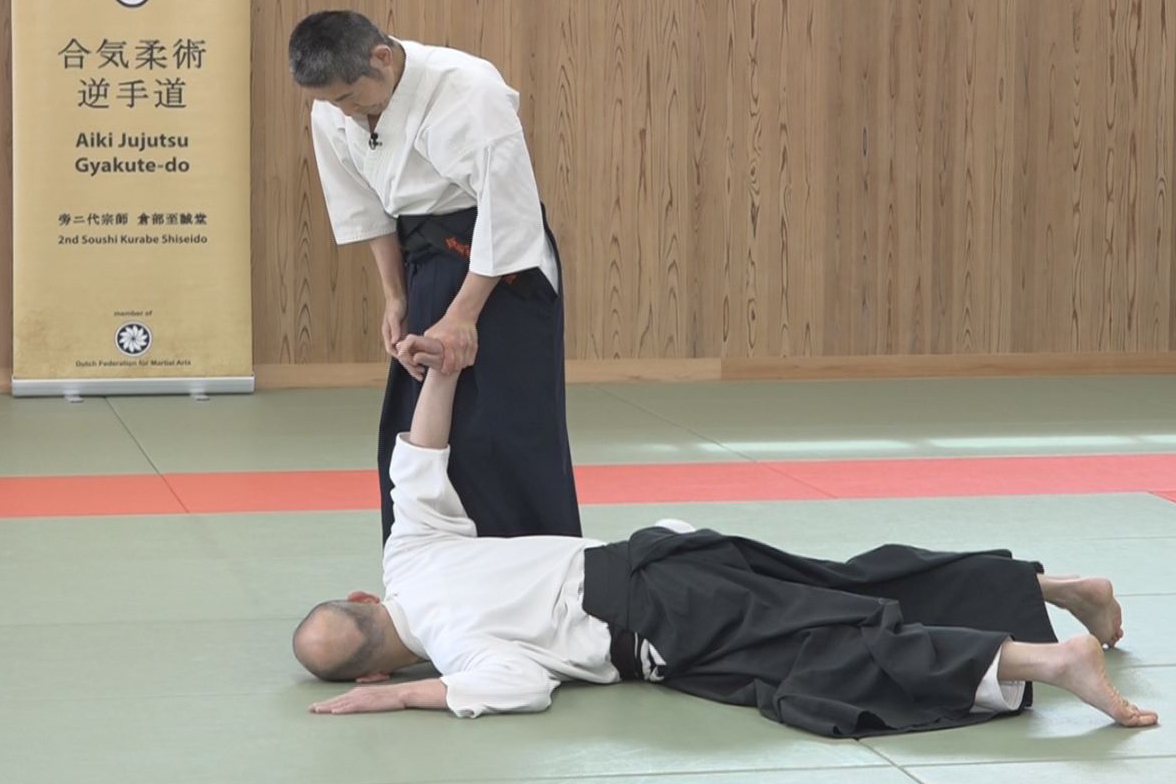
Lesson 15 - Advanced tech. by Undetectable F. T. #1
-
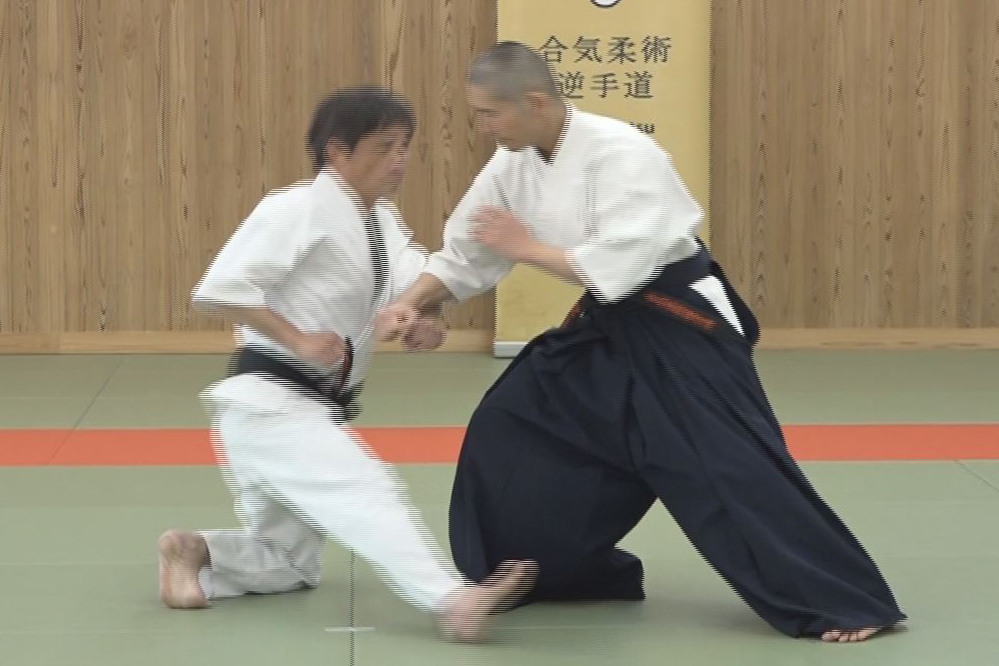
Lesson 14 - Advanced tech. by the Waving method #2
-

Lesson 13 - Advanced tech. by the Waving method #1
-
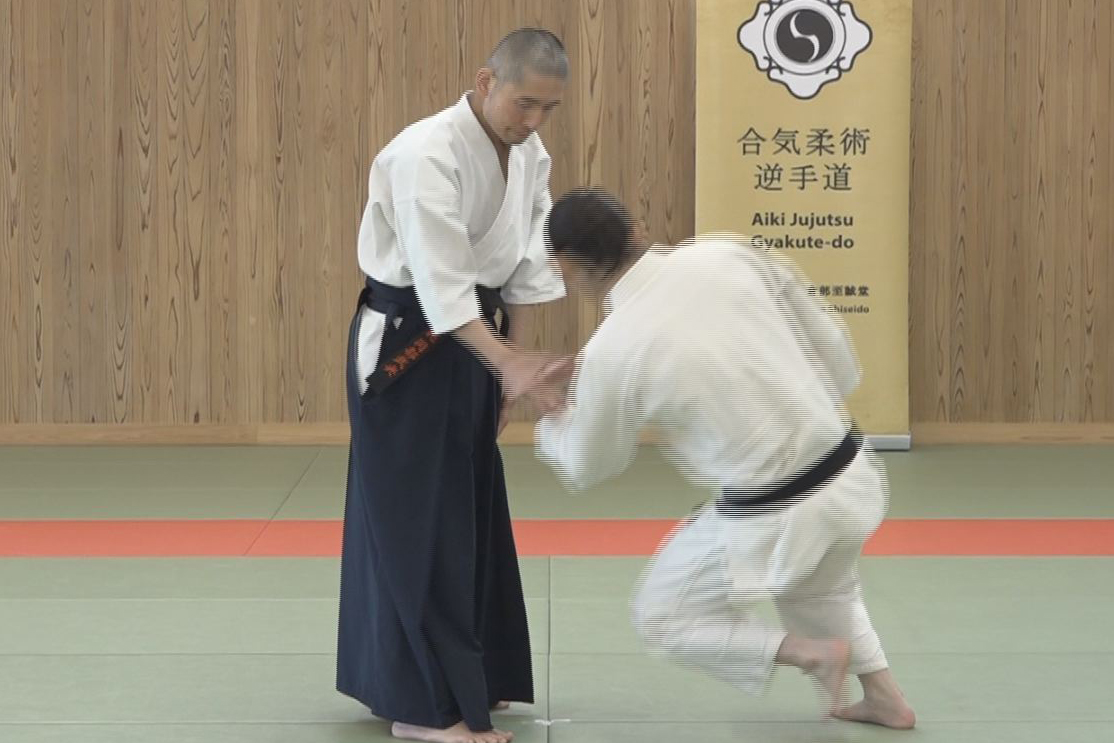
Lesson 12 - Gyaku-te by not Using Force nor AIKI
-
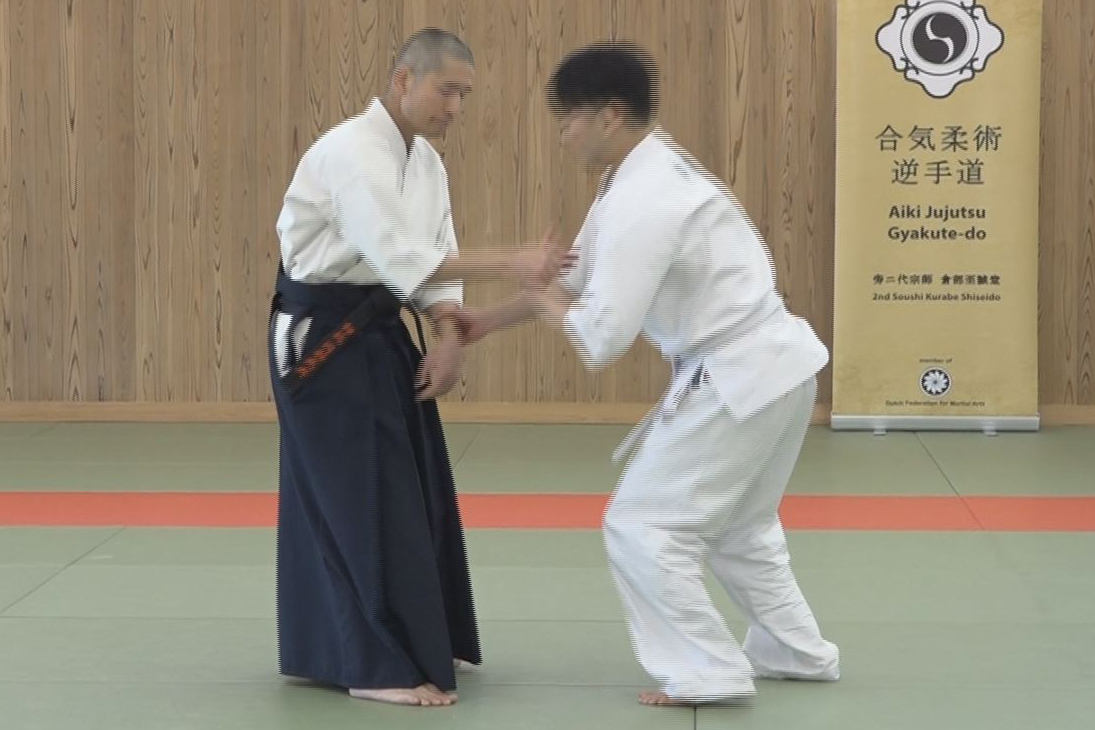
Lesson 11 - Gyaku-te Realized by the AIKI Method
-
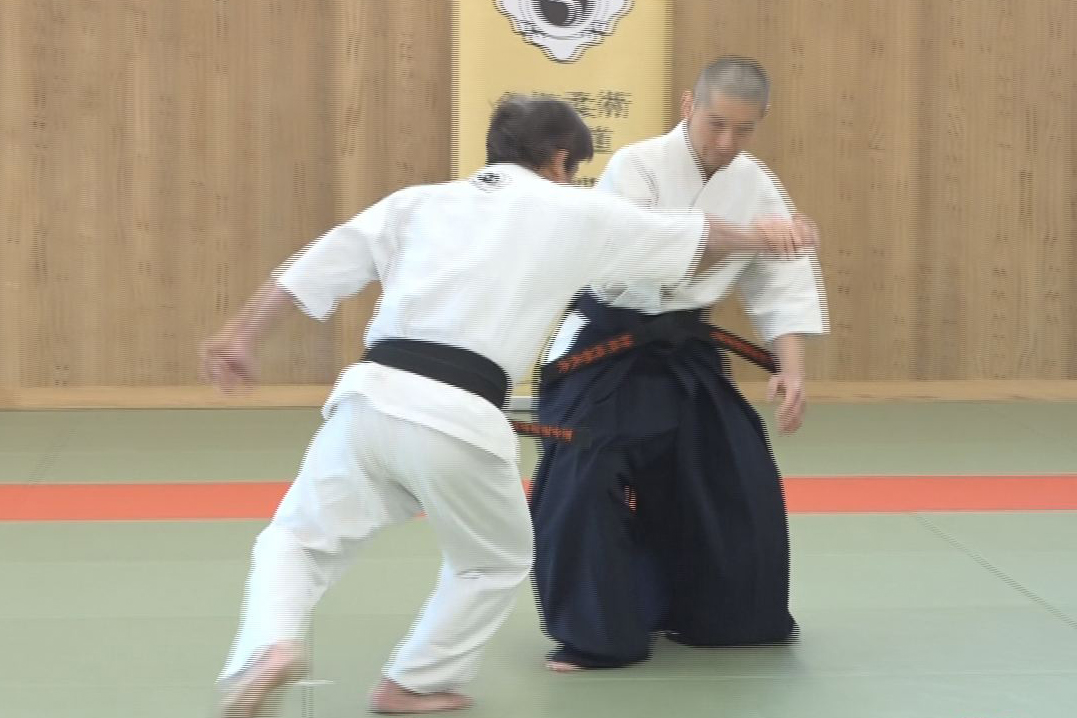
Lesson 10 - Application of Force Equilibrium method
-
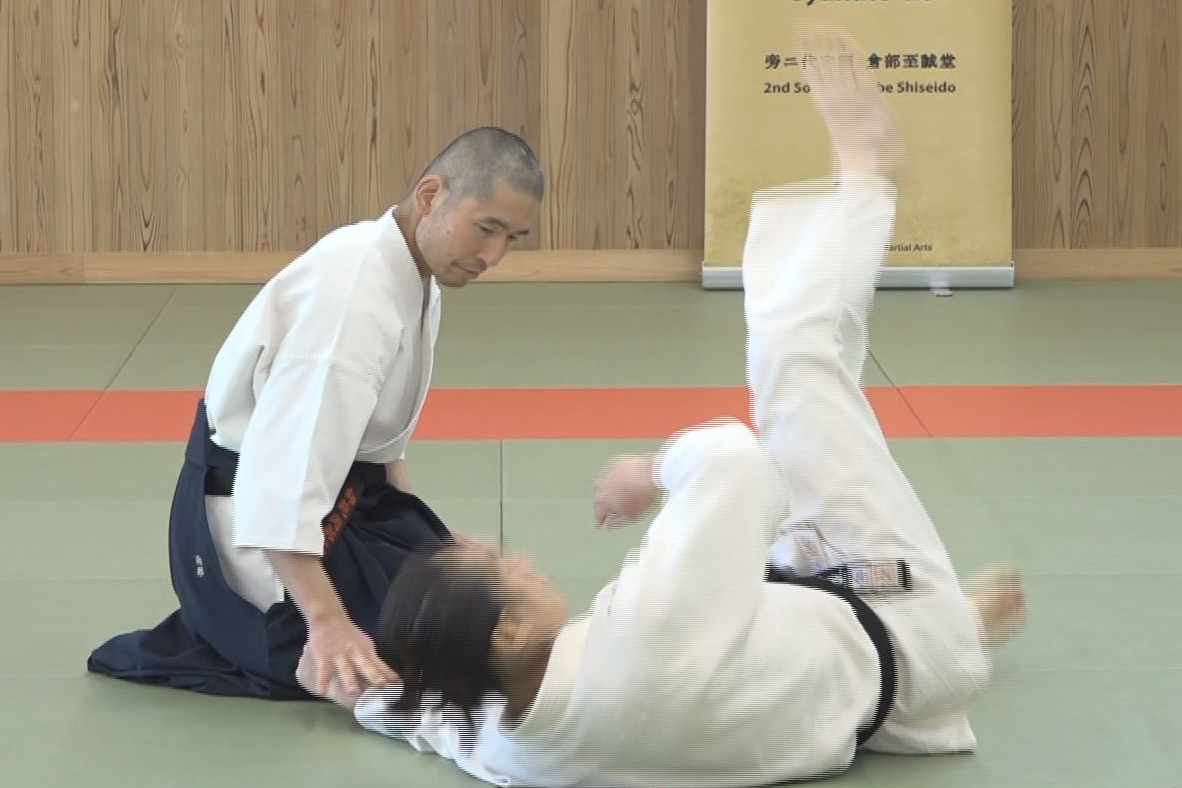
Lesson 9 - Force Equilibrium
-
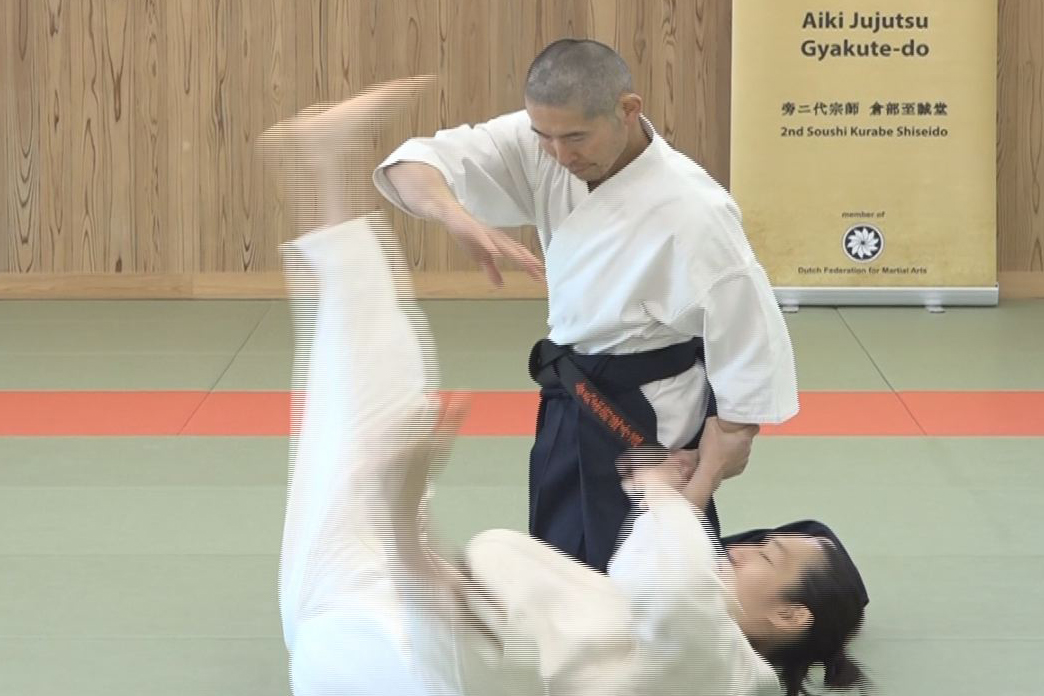
Lesson 8 - Application of Targeted Force Transfer
-

Lesson 7 - Targeted Force Transfer
-

Lesson 6 - Application of AIKI Connection
-
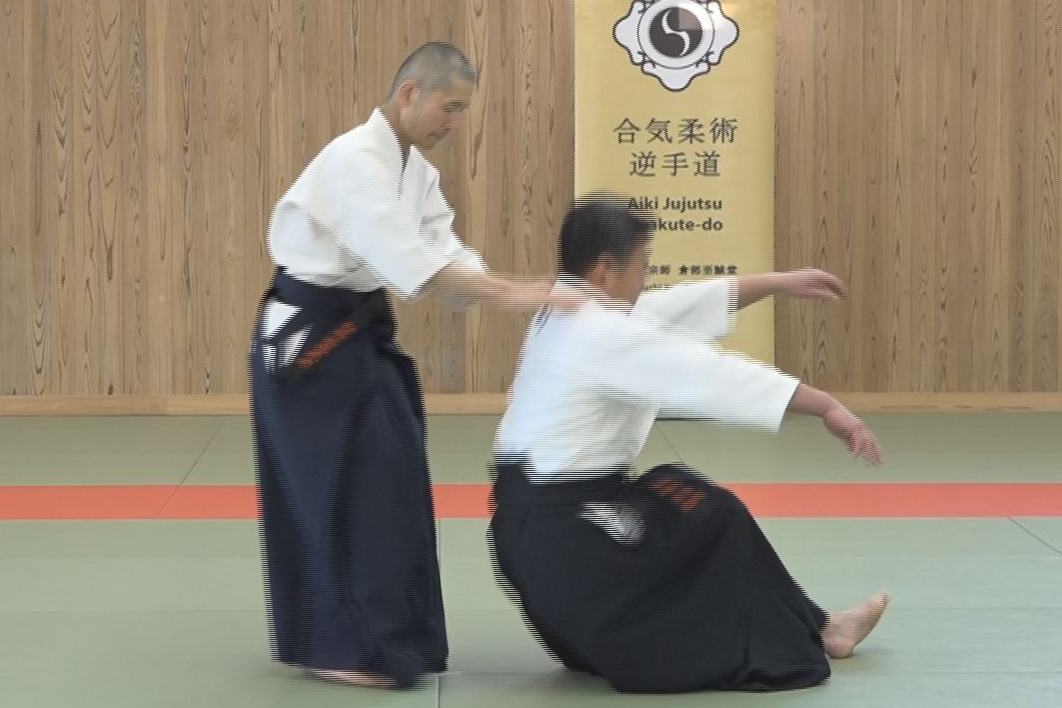
Lesson 5 - AIKI Connection
-

Lesson 4 - Application of Nondetectable Force Transfer
-
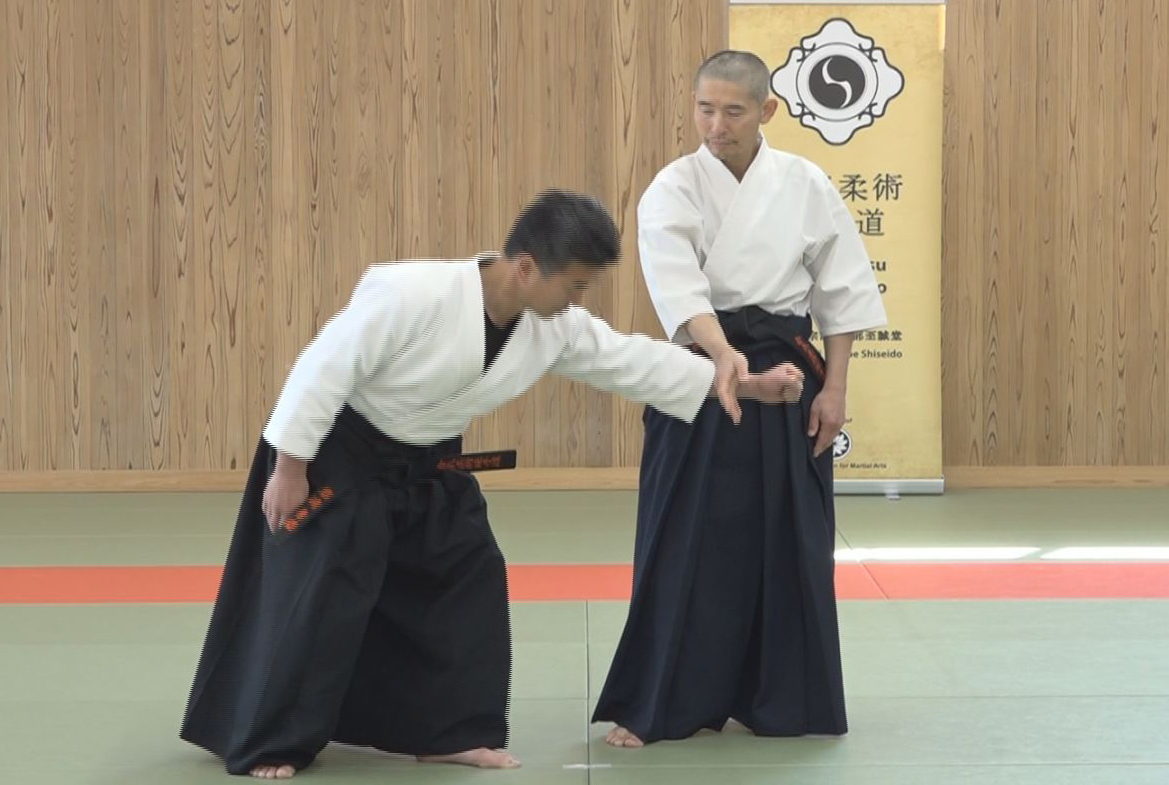
Lesson 3 - Explanation of Undetectable Force Transfer
-

Lesson 2 - Application of Waving Method
-
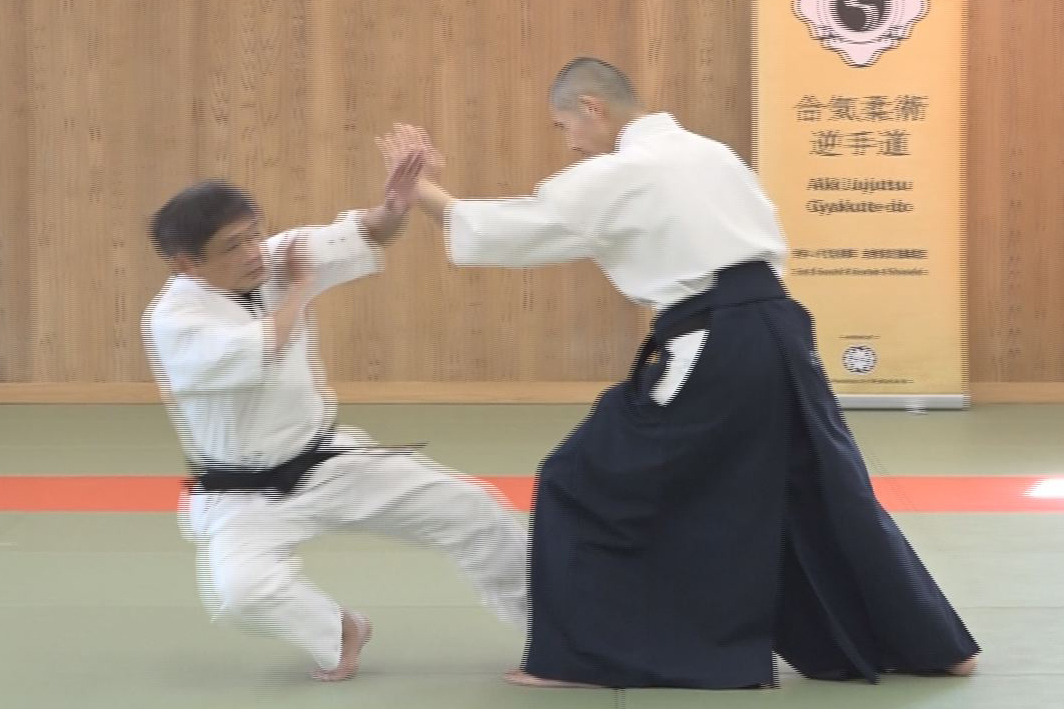
Lesson 1 - The Explanation of Waving Method
-
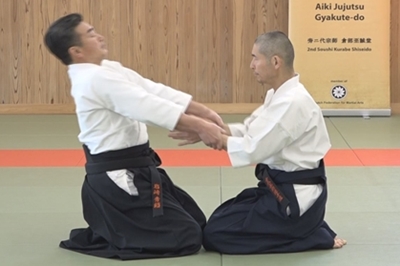
Introduction with video
and Knowledge of AIKI



